

16 Characteristics Of A Critical Thinking Classroom
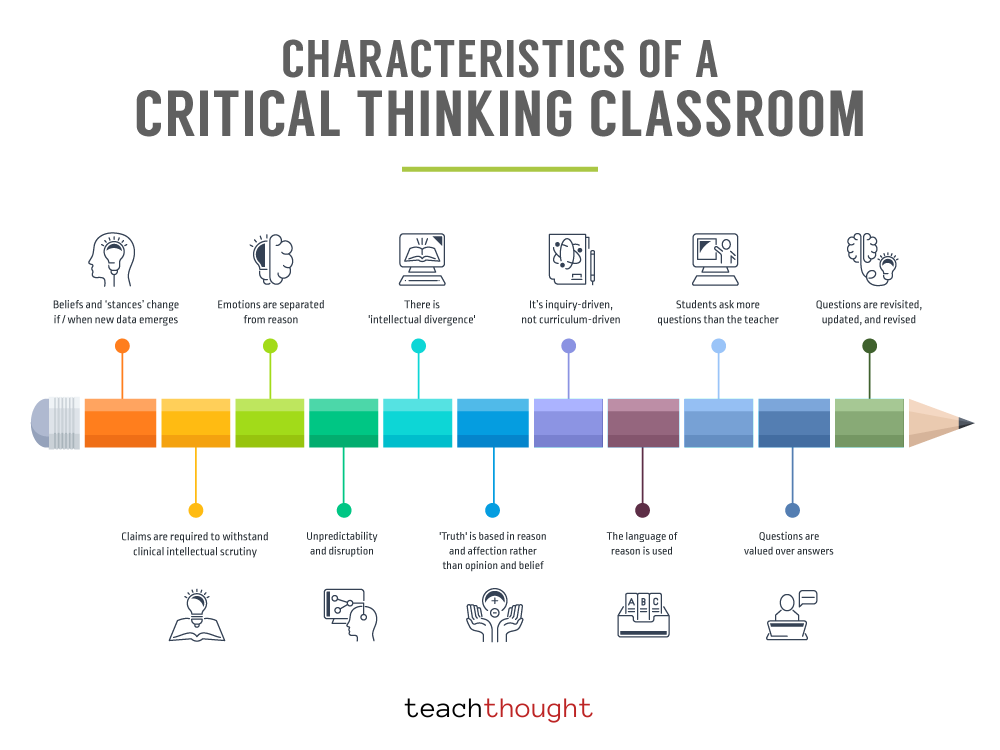
What Are The Characteristics Of A Critical Thinking Classroom?
by Terry Heick
The premise here is straightforward: clarifying what critical thinking might ‘look like’ in the classroom. Put another way, what are some indicators that rational thought and careful, critical thinking is not just ‘visible,’ but a part of the culture of a classroom.
In Critical Thinking Is A Mindset , I offered that, “Just as math can be said to be a kind of language and science is a way of thinking, critical thinking (while also being a ‘way’ of thinking) is first a state of mind–a willingness to do so both preceded and proceeded by a motley collection of presuppositions and premises and tendencies and cognitive defaults and even eventually personality traits that manifest when you read a book or have a discussion or skim a news headline or research an idea.”
I also discussed this idea in Teaching Disruptively, when I said, “inquiry-based learning (or critical thinking) that doesn’t just encourage students to ‘discover’ some preselected poet you had in mind, but find their own reasons for reading poetry—then finding their own poets.And perhaps most of all, by creating self-directed learners that can ask the right question at the right time within the right community to affect the kind of change that lasts.”
This concept also surfaced in dozens of other things I’ve written over the years, from Characteristics Of High-Performing Classrooms to Are You Teaching Content Or Are You Teaching Thought? to Correcting The Deficit In Critical Thinking when I wondered if maybe we should, create “learning models that require critical thinking–learning models that cannot function if students (all students) don’t think critically. This would be much like a rowboat where everyone has to row and stops if someone stops rowing; alternatively, break apart the boats completely so every student must row themselves.) someone stops rowing; alternatively, break apart the boats completely so every student must row themselves.”
Which brings us to this post. How do you know if your students are ‘thinking critically’? Of course, the answer depends on a scores and scores of factors, from the grade level and content area you teach to your relationships with students and the nature of your curriculum, units, lessons, and activities. But below are some examples that, if witnessed with any consistency at all, might be a good sign that your students are thinking.
What Are Indicators Of Critical Thinking?
Beliefs and ‘stances’ change if/when new data emerges.
The quality of knowledge and data is more important than an intellectual ‘stance’ of personal opinion.
Claims made–by anyone from the teacher and students to the authors and experts they study–are required to withstand clinical, good faith intellectual scrutiny.
Emotions are separated from reason. That is, they are seen as effects of thoughts rather than equal to thoughts or worthy of similar scrutiny, application, validation, acclaim, etc.
Unpredictability and ‘disruption’ (of ideas, some planning, assessment forms, traditional thinking patterns, etc.)
‘Intellectual divergence’ where thinkers seek to be in the company of evidence, truth, data, and perspective and are ‘diverge’ from one another/you/authors, etc. not emotionally (though that’s okay at times) but conceptually and intellectually.
‘Truth’ is based in reason and affection rather than opinion and belief.
Learning is inquiry-driven (through curiosity and knowledge demands), not curriculum-driven.
Students ask–then improve–questions to drive lessons, projects, discussions, etc.
The language of reason is used: words and phrases that clarify and endorse uncertainty and the need for more knowledge/data, sentence stems that clarifying positions or seek to clarify others, neutral transitional statements, etc.
Literacy in fallacies and biases. That is, heuristics, cognitive biases, and logical fallacies are discussed frequently and without ‘great prompting’ and effort.
The legacy of ideas and their origin/momentum/endorsement/change over time in response to data and new thinking, etc.
Humility. (This is at the core of rational, critical thought. Humility says, ‘I’m not sure’ or ‘I don’t know enough to have an informed opinion’ or ‘Let’s gain knowledge so that we can reduce uncertainty.’)
Students ask more questions than the teacher.
Questions are valued over answers.
Questions are revisited, updated, and revised.
About The Author
Terrell heick.
- Research Article
Critical Thinking Skills in the Classroom and Beyond
Teaching Strategies
Becoming a critical thinker isn’t an unreachable goal. As Arthur Aufderheide, the Mummy Doctor, once said, “All knowledge is connected to all other knowledge. The fun is in making the connections.”
What does that have to do with critical thinking? Everything! Critical thinking is taking our natural curiosity and making meaningful connections. We solve problems daily, and critical thinking plays an essential role in the process. Observing, analyzing, and maybe even failing as we process solutions to life’s everyday puzzles is necessary. Critical thinking isn’t about acting on your beliefs. It extends to reasoning, communication, reflection, and action.
With roots dating back to the mid-late 20th century , the term "critical thinking" has evolved through the years. It takes discipline to critically think because it requires questioning, open-mindedness, and problem-solving skills . Developing critical thinking skills in students is vital to success in all content areas and extracurricular activities.
What does critical thinking look like in the classroom?
Critical thinking in the classroom looks like examining and brainstorming. It’s a fearlessness to analyze, test, and even reject ideas. It’s metacognition , which is simply thinking about thinking. Critical thinking happens when teachers ask thought-provoking questions and resist the urge to generate ideas for students.
What can teachers do to foster critical thinking?
- Ask questions without one specific answer to find.
- Allow students to explain their thinking with pictures, numbers, or words.
- Support the productive struggle .
- Brainstorm as a whole class so that students hear the thoughts of others.
- Compare and contrast! Get students to recognize and understand different sides to one issue.
- Make connections to prior knowledge.
- Encourage students to dig deeper by considering and analyzing alternatives to their first reactions and answers.
- Have students explain why they chose to do tasks in certain ways.
- Share helpful processes to try when things seem tricky. Invite students to give their tips.
- Provide opportunities for students to gather and evaluate information .
- Don’t stop when an assignment is over. Take valuable time for reflection.
Critical thinking beyond the classroom
Critical thinking is one skill that transfers from the classroom to the real world. It’s also necessary for success in academic and professional careers . Every single one of us has to ask purposeful questions and communicate our thoughts effectively. Critical thinking is more than that! It improves decision-making and objective reasoning. It allows us to move beyond emotional reactions to analysis, conclusions, and positive and negative consequences. True critical thinking also involves reflection to see the cause and effect of our decisions.
Critical thinking is one skill that transfers from the classroom to the real world.
Helping your students develop critical thinking skills benefits the whole child. A lot is going on in their worlds. Understanding how to think through decisions is a crucial skill. Set your students up for success with plenty of opportunities for critical thinking in your classroom!
ExploreLearning delivers critical thinking opportunities in math and science that are serious fun! Take a closer look!
Incite curiosity and invite interactions in STEM for students 3-12.
Help students 3-5 build deep conceptual fractions understanding.
Give students 2-5 the foundation they need to succeed at math.
Prepare K-2 students for success in STEM with Science4Us.
You might also like these stories...
Sign up to get the latest updates from ExploreLearning via occasional email.

The Will to Teach
Critical Thinking in the Classroom: A Guide for Teachers
In the ever-evolving landscape of education, teaching students the skill of critical thinking has become a priority. This powerful tool empowers students to evaluate information, make reasoned judgments, and approach problems from a fresh perspective. In this article, we’ll explore the significance of critical thinking and provide effective strategies to nurture this skill in your students.
Why is Fostering Critical Thinking Important?
Strategies to cultivate critical thinking, real-world example, concluding thoughts.
Critical thinking is a key skill that goes far beyond the four walls of a classroom. It equips students to better understand and interact with the world around them. Here are some reasons why fostering critical thinking is important:
- Making Informed Decisions: Critical thinking enables students to evaluate the pros and cons of a situation, helping them make informed and rational decisions.
- Developing Analytical Skills: Critical thinking involves analyzing information from different angles, which enhances analytical skills.
- Promoting Independence: Critical thinking fosters independence by encouraging students to form their own opinions based on their analysis, rather than relying on others.

Creating an environment that encourages critical thinking can be accomplished in various ways. Here are some effective strategies:
- Socratic Questioning: This method involves asking thought-provoking questions that encourage students to think deeply about a topic. For example, instead of asking, “What is the capital of France?” you might ask, “Why do you think Paris became the capital of France?”
- Debates and Discussions: Debates and open-ended discussions allow students to explore different viewpoints and challenge their own beliefs. For example, a debate on a current event can engage students in critical analysis of the situation.
- Teaching Metacognition: Teaching students to think about their own thinking can enhance their critical thinking skills. This can be achieved through activities such as reflective writing or journaling.
- Problem-Solving Activities: As with developing problem-solving skills , activities that require students to find solutions to complex problems can also foster critical thinking.
As a school leader, I’ve seen the transformative power of critical thinking. During a school competition, I observed a team of students tasked with proposing a solution to reduce our school’s environmental impact. Instead of jumping to obvious solutions, they critically evaluated multiple options, considering the feasibility, cost, and potential impact of each. They ultimately proposed a comprehensive plan that involved water conservation, waste reduction, and energy efficiency measures. This demonstrated their ability to critically analyze a problem and develop an effective solution.
Critical thinking is an essential skill for students in the 21st century. It equips them to understand and navigate the world in a thoughtful and informed manner. As a teacher, incorporating strategies to foster critical thinking in your classroom can make a lasting impact on your students’ educational journey and life beyond school.
1. What is critical thinking? Critical thinking is the ability to analyze information objectively and make a reasoned judgment.
2. Why is critical thinking important for students? Critical thinking helps students make informed decisions, develop analytical skills, and promotes independence.
3. What are some strategies to cultivate critical thinking in students? Strategies can include Socratic questioning, debates and discussions, teaching metacognition, and problem-solving activities.
4. How can I assess my students’ critical thinking skills? You can assess critical thinking skills through essays, presentations, discussions, and problem-solving tasks that require thoughtful analysis.
5. Can critical thinking be taught? Yes, critical thinking can be taught and nurtured through specific teaching strategies and a supportive learning environment.
Related Posts
7 simple strategies for strong student-teacher relationships.
Getting to know your students on a personal level is the first step towards building strong relationships. Show genuine interest in their lives outside the classroom.

Connecting Learning to Real-World Contexts: Strategies for Teachers
When students see the relevance of their classroom lessons to their everyday lives, they are more likely to be motivated, engaged, and retain information.

Encouraging Active Involvement in Learning: Strategies for Teachers
Active learning benefits students by improving retention of information, enhancing critical thinking skills, and encouraging a deeper understanding of the subject matter.

Collaborative and Cooperative Learning: A Guide for Teachers
These methods encourage students to work together, share ideas, and actively participate in their education.

Experiential Teaching: Role-Play and Simulations in Teaching
These interactive techniques allow students to immerse themselves in practical, real-world scenarios, thereby deepening their understanding and retention of key concepts.

Project-Based Learning Activities: A Guide for Teachers
Project-Based Learning is a student-centered pedagogy that involves a dynamic approach to teaching, where students explore real-world problems or challenges.
Leave a Reply Cancel reply
Your email address will not be published. Required fields are marked *
Save my name, email, and website in this browser for the next time I comment.
- Our Mission
Helping Students Hone Their Critical Thinking Skills
Used consistently, these strategies can help middle and high school teachers guide students to improve much-needed skills.

Critical thinking skills are important in every discipline, at and beyond school. From managing money to choosing which candidates to vote for in elections to making difficult career choices, students need to be prepared to take in, synthesize, and act on new information in a world that is constantly changing.
While critical thinking might seem like an abstract idea that is tough to directly instruct, there are many engaging ways to help students strengthen these skills through active learning.
Make Time for Metacognitive Reflection
Create space for students to both reflect on their ideas and discuss the power of doing so. Show students how they can push back on their own thinking to analyze and question their assumptions. Students might ask themselves, “Why is this the best answer? What information supports my answer? What might someone with a counterargument say?”
Through this reflection, students and teachers (who can model reflecting on their own thinking) gain deeper understandings of their ideas and do a better job articulating their beliefs. In a world that is go-go-go, it is important to help students understand that it is OK to take a breath and think about their ideas before putting them out into the world. And taking time for reflection helps us more thoughtfully consider others’ ideas, too.
Teach Reasoning Skills
Reasoning skills are another key component of critical thinking, involving the abilities to think logically, evaluate evidence, identify assumptions, and analyze arguments. Students who learn how to use reasoning skills will be better equipped to make informed decisions, form and defend opinions, and solve problems.
One way to teach reasoning is to use problem-solving activities that require students to apply their skills to practical contexts. For example, give students a real problem to solve, and ask them to use reasoning skills to develop a solution. They can then present their solution and defend their reasoning to the class and engage in discussion about whether and how their thinking changed when listening to peers’ perspectives.
A great example I have seen involved students identifying an underutilized part of their school and creating a presentation about one way to redesign it. This project allowed students to feel a sense of connection to the problem and come up with creative solutions that could help others at school. For more examples, you might visit PBS’s Design Squad , a resource that brings to life real-world problem-solving.
Ask Open-Ended Questions
Moving beyond the repetition of facts, critical thinking requires students to take positions and explain their beliefs through research, evidence, and explanations of credibility.
When we pose open-ended questions, we create space for classroom discourse inclusive of diverse, perhaps opposing, ideas—grounds for rich exchanges that support deep thinking and analysis.
For example, “How would you approach the problem?” and “Where might you look to find resources to address this issue?” are two open-ended questions that position students to think less about the “right” answer and more about the variety of solutions that might already exist.
Journaling, whether digitally or physically in a notebook, is another great way to have students answer these open-ended prompts—giving them time to think and organize their thoughts before contributing to a conversation, which can ensure that more voices are heard.
Once students process in their journal, small group or whole class conversations help bring their ideas to life. Discovering similarities between answers helps reveal to students that they are not alone, which can encourage future participation in constructive civil discourse.
Teach Information Literacy
Education has moved far past the idea of “Be careful of what is on Wikipedia, because it might not be true.” With AI innovations making their way into classrooms, teachers know that informed readers must question everything.
Understanding what is and is not a reliable source and knowing how to vet information are important skills for students to build and utilize when making informed decisions. You might start by introducing the idea of bias: Articles, ads, memes, videos, and every other form of media can push an agenda that students may not see on the surface. Discuss credibility, subjectivity, and objectivity, and look at examples and nonexamples of trusted information to prepare students to be well-informed members of a democracy.
One of my favorite lessons is about the Pacific Northwest tree octopus . This project asks students to explore what appears to be a very real website that provides information on this supposedly endangered animal. It is a wonderful, albeit over-the-top, example of how something might look official even when untrue, revealing that we need critical thinking to break down “facts” and determine the validity of the information we consume.
A fun extension is to have students come up with their own website or newsletter about something going on in school that is untrue. Perhaps a change in dress code that requires everyone to wear their clothes inside out or a change to the lunch menu that will require students to eat brussels sprouts every day.
Giving students the ability to create their own falsified information can help them better identify it in other contexts. Understanding that information can be “too good to be true” can help them identify future falsehoods.
Provide Diverse Perspectives
Consider how to keep the classroom from becoming an echo chamber. If students come from the same community, they may have similar perspectives. And those who have differing perspectives may not feel comfortable sharing them in the face of an opposing majority.
To support varying viewpoints, bring diverse voices into the classroom as much as possible, especially when discussing current events. Use primary sources: videos from YouTube, essays and articles written by people who experienced current events firsthand, documentaries that dive deeply into topics that require some nuance, and any other resources that provide a varied look at topics.
I like to use the Smithsonian “OurStory” page , which shares a wide variety of stories from people in the United States. The page on Japanese American internment camps is very powerful because of its first-person perspectives.
Practice Makes Perfect
To make the above strategies and thinking routines a consistent part of your classroom, spread them out—and build upon them—over the course of the school year. You might challenge students with information and/or examples that require them to use their critical thinking skills; work these skills explicitly into lessons, projects, rubrics, and self-assessments; or have students practice identifying misinformation or unsupported arguments.
Critical thinking is not learned in isolation. It needs to be explored in English language arts, social studies, science, physical education, math. Every discipline requires students to take a careful look at something and find the best solution. Often, these skills are taken for granted, viewed as a by-product of a good education, but true critical thinking doesn’t just happen. It requires consistency and commitment.
In a moment when information and misinformation abound, and students must parse reams of information, it is imperative that we support and model critical thinking in the classroom to support the development of well-informed citizens.
JavaScript seems to be disabled in your browser. For the best experience on our site, be sure to turn on Javascript in your browser.
- Order Tracking
- Create an Account

200+ Award-Winning Educational Textbooks, Activity Books, & Printable eBooks!
- Compare Products
Reading, Writing, Math, Science, Social Studies
- Search by Book Series
- Algebra I & II Gr. 7-12+
- Algebra Magic Tricks Gr. 2-12+
- Algebra Word Problems Gr. 7-12+
- Balance Benders Gr. 2-12+
- Balance Math & More! Gr. 2-12+
- Basics of Critical Thinking Gr. 4-7
- Brain Stretchers Gr. 5-12+
- Building Thinking Skills Gr. Toddler-12+
- Building Writing Skills Gr. 3-7
- Bundles - Critical Thinking Gr. PreK-9
- Bundles - Language Arts Gr. K-8
- Bundles - Mathematics Gr. PreK-9
- Bundles - Multi-Subject Curriculum Gr. PreK-12+
- Bundles - Test Prep Gr. Toddler-12+
- Can You Find Me? Gr. PreK-1
- Complete the Picture Math Gr. 1-3
- Cornell Critical Thinking Tests Gr. 5-12+
- Cranium Crackers Gr. 3-12+
- Creative Problem Solving Gr. PreK-2
- Critical Thinking Activities to Improve Writing Gr. 4-12+
- Critical Thinking Coloring Gr. PreK-2
- Critical Thinking Detective Gr. 3-12+
- Critical Thinking Tests Gr. PreK-6
- Critical Thinking for Reading Comprehension Gr. 1-5
- Critical Thinking in United States History Gr. 6-12+
- CrossNumber Math Puzzles Gr. 4-10
- Crypt-O-Words Gr. 2-7
- Crypto Mind Benders Gr. 3-12+
- Daily Mind Builders Gr. 5-12+
- Dare to Compare Math Gr. 2-7
- Developing Critical Thinking through Science Gr. 1-8
- Dr. DooRiddles Gr. PreK-12+
- Dr. Funster's Gr. 2-12+
- Editor in Chief Gr. 2-12+
- Fun-Time Phonics! Gr. PreK-2
- Half 'n Half Animals Gr. K-4
- Hands-On Thinking Skills Gr. K-1
- Inference Jones Gr. 1-6
- James Madison Gr. 10-12+
- Jumbles Gr. 3-5
- Language Mechanic Gr. 4-7
- Language Smarts Gr. 1-4
- Mastering Logic & Math Problem Solving Gr. 6-9
- Math Analogies Gr. K-9
- Math Detective Gr. 3-8
- Math Games Gr. 3-8
- Math Mind Benders Gr. 5-12+
- Math Ties Gr. 4-8
- Math Word Problems Gr. 4-10
- Mathematical Reasoning Gr. Toddler-11
- Middle School Science Gr. 6-8
- Mind Benders Gr. PreK-12+
- Mind Building Math Gr. K-1
- Mind Building Reading Gr. K-1
- Novel Thinking Gr. 3-6
- OLSAT® Test Prep Gr. PreK-K
- Organizing Thinking Gr. 2-8
- Pattern Explorer Gr. 3-9
- Practical Critical Thinking Gr. 8-12+
- Punctuation Puzzler Gr. 3-8
- Reading Detective Gr. 3-12+
- Red Herring Mysteries Gr. 4-12+
- Red Herrings Science Mysteries Gr. 4-9
- Science Detective Gr. 3-6
- Science Mind Benders Gr. PreK-3
- Science Vocabulary Crossword Puzzles Gr. 4-6
- Sciencewise Gr. 4-12+
- Scratch Your Brain Gr. 2-12+
- Sentence Diagramming Gr. 3-12+
- Smarty Pants Puzzles Gr. 3-12+
- Snailopolis Gr. K-4
- Something's Fishy at Lake Iwannafisha Gr. 5-9
- Teaching Technology Gr. 3-12+
- Tell Me a Story Gr. PreK-1
- Think Analogies Gr. 3-12+
- Think and Write Gr. 3-8
- Think-A-Grams Gr. 4-12+
- Thinking About Time Gr. 3-6
- Thinking Connections Gr. 4-12+
- Thinking Directionally Gr. 2-6
- Thinking Skills & Key Concepts Gr. PreK-2
- Thinking Skills for Tests Gr. PreK-5
- U.S. History Detective Gr. 8-12+
- Understanding Fractions Gr. 2-6
- Visual Perceptual Skill Building Gr. PreK-3
- Vocabulary Riddles Gr. 4-8
- Vocabulary Smarts Gr. 2-5
- Vocabulary Virtuoso Gr. 2-12+
- What Would You Do? Gr. 2-12+
- Who Is This Kid? Colleges Want to Know! Gr. 9-12+
- Word Explorer Gr. 6-8
- Word Roots Gr. 3-12+
- World History Detective Gr. 6-12+
- Writing Detective Gr. 3-6
- You Decide! Gr. 6-12+

- Special of the Month
- Sign Up for our Best Offers
- Bundles = Greatest Savings!
- Sign Up for Free Puzzles
- Sign Up for Free Activities
- Toddler (Ages 0-3)
- PreK (Ages 3-5)
- Kindergarten (Ages 5-6)
- 1st Grade (Ages 6-7)
- 2nd Grade (Ages 7-8)
- 3rd Grade (Ages 8-9)
- 4th Grade (Ages 9-10)
- 5th Grade (Ages 10-11)
- 6th Grade (Ages 11-12)
- 7th Grade (Ages 12-13)
- 8th Grade (Ages 13-14)
- 9th Grade (Ages 14-15)
- 10th Grade (Ages 15-16)
- 11th Grade (Ages 16-17)
- 12th Grade (Ages 17-18)
- 12th+ Grade (Ages 18+)
- Test Prep Directory
- Test Prep Bundles
- Test Prep Guides
- Preschool Academics
- Store Locator
- Submit Feedback/Request
- Sales Alerts Sign-Up
- Technical Support
- Mission & History
- Articles & Advice
- Testimonials
- Our Guarantee
- New Products
- Free Activities
- Libros en Español
How To Promote Critical Thinking In Your Classroom
Promoting Thinking
November 25, 2006, by The Critical Thinking Co. Staff
Modeling of critical thinking skills by instructors is crucial for teaching critical thinking successfully. By making your own thought processes explicit in class - explaining your reasoning, evaluating evidence for a claim, probing the credibility of a source, or even describing what has puzzled or confused you - you provide a powerful example to students, particularly if you invite them to join in; e.g., "Can you see where we're headed with this?" "I can't think of other explanations; can you?" "This idea/principle struck me as difficult or confusing at first, but here's how I figured it out." You can encourage students to emulate this by using them in demonstrations, asking them to "think out loud" in order for classmates to observe how they reason through a problem.
Develop the habit of asking questions that require students to think critically, and tell students that you really expect them to give answers! In particular, Socratic questioning encourages students to develop and clarify their thinking: e.g., "Would your answer hold in all cases?" "How would you respond to a counter-example or counter-argument?" "Explain how you arrived at that answer?"
This is another skill that students can learn from your example, and can use in working with each other. Providing regular opportunities for pair or small group discussions after major points or demonstrations during lectures is also important: this allows students to process the new material, connect it to previously learned topics, and practice asking questions that promote further critical thinking. Obviously, conveying genuine respect for student input is essential. Communicating the message that you value and support student contributions and efforts to think critically increases confidence, and motivates students to continue building their thinking skills. An essential component of this process is the creation of a climate where students feel comfortable with exploring the process of reasoning through a problem without being "punished" for getting the wrong answer.
Researchers have found consistently that interaction among students, in the form of well-structured group discussions plays a central role in stimulating critical thinking. Discussing course material and its applications allows students to formulate and test hypotheses, practice asking thought-provoking questions, hear other perspectives, analyze claims, evaluate evidence, and explain and justify their reasoning. As they become more sophisticated and fluent in thinking critically, students can observe and critique each others' reasoning skills.
Critical Thinking: Facilitating and Assessing the 21st Century Skills in Education
So many times we hear our students say, “Why am I learning this?”

I believe that Critical Thinking is the spark that begins the process of authentic learning. Before going further, we must first develop an idea of what learning is… and what learning is not. So many times we hear our students say, “Why am I learning this?” The reason they ask is because they have not really experienced the full spectrum of learning, and because of this are actually not learning to a full rewarding extent! We might say they are being exposed to surface learning and not authentic (real) learning. The act of authentic learning is actually an exciting and engaging concept. It allows students to see real meaning and begin to construct their own knowledge. Critical Thinking is core to learning. It is rewarding, engaging, and life long. Without critical thinking students are left to a universe of concepts and memorization. Yes… over twelve years of mediocrity! When educators employ critical thinking in their classrooms, a whole new world of understanding is opened up. What are some reasons to facilitate critical thinking with our students? Let me begin:
Ten Reasons For Student Critical Thinking in the classroom
- Allows for necessary inquiry that makes learning exciting
- Provides a method to go beyond memorization to promote understanding.
- Allows students to visualize thoughts, concepts, theories, models & possibilities.
- Promotes curriculum standards, trans-disciplinary ideas & real world connections.
- Encourages a classroom culture of collaboration that promotes deeper thinking.
- Builds skills of problem solving, making implications, & determining consequences.
- Facilitates goal setting, promotion of process, and perseverance to achieve.
- Teaches self reflection and critique, and the ability to listen to others’ thoughts.
- Encourages point of view while developing persuasive skills.
- Guides interpretation while developing a skill to infer and draw conclusions.
I am excited by the spark that critical thinking ignites to support real and authentic learning in the classroom. I often wonder how much time students spend in the process of critical thinking in the classroom. I ask you to reflect on your typical school day. Are your students spending time in area of surface learning , or are they plunging into the engaging culture of deeper (real) learning? At the same time … how are you assessing your students? So many times as educators, we are bound by the standards, and we forget the importance of promoting that critical thinking process that makes our standards come alive with understanding. A culture of critical thinking is not automatic, though with intentional planning it can become a reality. Like the other 21st century skills, it must be built and continuously facilitated. Let’s take a look at how, we as educators, can do this.
Ten Ways to Facilitate Student Critical Thinking in the Classroom and School
- Design Critical Thinking Activities. (This might include mind mapping, making thinking visible, Socratic discussions, meta-cognitive mind stretches, Build an inquiry wall with students and talk about the process of thinking”
- Provide time for students to collaborate. (Collaboration can be the button that starts critical thinking. It provides group thinking that builds on the standards. Have students work together while solving multi-step and higher order thinking problems. Sometimes this might mean slow down to increase the learning.)
- Provide students with a Critical Thinking rubric. (Have them look at the rubric before a critical thinking activity, and once again when they are finished)
- Make assessment of Critical Thinking an ongoing effort. (While the teacher can assess, have students assess themselves. Self assessment can be powerful)
- Concentrate on specific indicators in a rubric. (There are various indicators such as; provides inquiry, answers questions, builds an argument etc. Concentrate on just one indicator while doing a lesson. There can even be an exit ticket reflection)
- Integrate the idea of Critical Thinking in any lesson. ( Do not teach this skill in isolation. How does is work with a lesson, stem activity, project built, etc. What does Critical Thinking look like in the online or blended environment? Think of online discussions.)
- Post a Critical Thinking Poster in the room. (This poster could be a copy of a rubric or even a list of “I Can Statements”. Point it out before a critical thinking activity.
- Make Critical Thinking part of your formative and summative assessment. (Move around the room, talk to groups and students, stop the whole group to make adjustments.)
- Point out Critical Thinking found in the content standards. (Be aware that content standards often have words like; infer, debate, conclude, solve, prioritize, compare and contrast, hypothesize, and research. Critical Thinking has always been part of the standards. Show your students Bloom’s Taxonomy and post in the room. Where are they in their learning?
- Plan for a school wide emphasis. (A culture that builds Critical Thinking is usually bigger then one classroom. Develop school-wide vocabulary, posters, and initiatives.)
I keep talking about the idea of surface learning and deeper learning. This can best be seen in Bloom’s Taxonomy. Often we start with Remembering. This might be essential in providing students the map to the further areas of Bloom’s. Of course, we then find the idea of Understanding. This is where I believe critical thinking begins. Sometimes we need to critically think in order to understand. In fact, you might be this doing right now. I believe that too much time might be spent in Remembering, which is why students get a false idea of what learning really is. As we look at the rest of Bloom’s ( Apply, Analyze, Evaluate, and Create) we can see the deeper learning take place. and even steps toward the transfer and internalization of the learning. Some educators even tip Bloom’s upside down, stating that the Creating at the top will build an understanding. This must be done with careful facilitation and intentional scaffold to make sure there is some surface learning. After-all, Critical Thinking will need this to build on.
I have been mentioning rubrics and assessment tools through out this post. To me, these are essential in building that culture of critical thinking in the classroom. I want to provide you with some great resources that will give your some powerful tools to assess the skill of Critical Thinking. Keep in mind that students can also self assess and journal using prompts from a Critical Thinking Rubric.
Seven Resources to Help with Assessment and Facilitation of Critical Thinking
- Habits of Mind – I think this is an awesome place to help teachers facilitate and assess critical thinking and more. Check out the free resources page which even has some wonderful posters. One of my favorites is the rubrics found on this research page . Decide on spending some time because there are a lot of great resources.
- PBLWorks – The number one place for PBL in the world is at PBLWorks. You may know it as the BUCK Institute or BIE. I am fortunate to be part of their National Faculty which is probably why I rank it as number one. I encourage you to visit their site for everything PBL. This link brings you to the resource area where you will discover some amazing rubrics to facilitate Critical Thinking. You will find rubrics for grade bands K-2, 3-5, and 6-12. This really is a great place to start. You will need to sign up to be a member of PBLWorks. This is a wonderful idea, after-all it is free!
- Microsoft Innovative Learning – This website contains some powerful rubrics for assessing the 21st Century skills. The link will bring you to a PDF file with Critical Thinking rubrics you can use tomorrow for any grade level. Check out this two page document defining the 4 C’s and a movie giving you even more of an explanation.
- New Tech School – This amazing PBL group of schools provide some wonderful Learning Rubrics in their free area. Here you will find an interesting collection of rubrics that assesses student learning in multiple areas. These are sure to get you off and started.
- Foundation for Critical Thinking – Check out this amazing page to help give you descriptors.
- Project Zero – While it is not necessarily assessment based, you will find some powerful routines for making thinking visible . As you conduct these types of activities you will find yourself doing some wonderful formative assessment of critical thinking.
- Education Week – Take a look at this resource that provides some great reasoning and some interesting links that provide a glimpse of critical thinking in the classroom.
Critical Thinking “I Can Statements”
As you can see, I believe that Critical Thinking is key to PBL, STEM, and Deeper Learning. It improves Communication and Collaboration, while promoting Creativity. I believe every student should have these following “I Can Statements” as part of their learning experience. Feel free to copy and use in your classroom. Perhaps this is a great starting place as you promote collaborative and powerful learning culture!
- I can not only answer questions, but can also think of new questions to ask
- I can take time to see what I am thinking to promote even better understanding
- I can attempt to see other peoples’ thinking while explaining my own
- I can look at a problem and determine needed steps to find a solution
- I can use proper collaboration skills to work with others productively to build solutions
- I can set a goal, design a plan, and persevere to accomplish the goal.
- I can map out strategies and processes that shows the action involved in a task.
- I can define and show my understanding of a concept, model, theory, or process.
- I can take time to reflect and productively critique my work and the work of others
- I can understand, observe, draw inferences, hypothesize and see implications.
cross-posted at 21centuryedtech.wordpress.com
Michael Gorman oversees one-to-one laptop programs and digital professional development for Southwest Allen County Schools near Fort Wayne, Indiana. He is a consultant for Discovery Education, ISTE, My Big Campus, and November Learning and is on the National Faculty for The Buck Institute for Education. His awards include district Teacher of the Year, Indiana STEM Educator of the Year and Microsoft’s 365 Global Education Hero. Read more at 21centuryedtech.wordpress.com .
Tech & Learning Newsletter
Tools and ideas to transform education. Sign up below.
5 Tips For Getting Online and In-Person Adjunct Teaching Positions
4 AI Tools I Actually Use As An Educator
Addressing The Critical Impact of Chronic Absenteeism
Most Popular

Developing critical thinking skills in the classroom
April 29, 2021
Critical thinking skills in the classroom: A teacher's guide to developing higher-order thinking and student reasoning.
Main, P (2021, April 29). Developing critical thinking skills in the classroom. Retrieved from https://www.structural-learning.com/post/what-is-critical-thinking
What is critical thinking?
Critical thinking is important in every aspect of our lives. It helps us make decisions, solve problems , and learn new information. But how do we develop these skills in school?
In order to become a well-rounded person who has developed critical thinking skills, students must first understand the importance of developing these skills. This means teaching students how to analyze data, evaluate arguments, and draw conclusions from evidence.
This article will help teachers teach critical thinking skills in the class room. We'll look at how to teach critical thinking skills using examples from history, science, math, literature, and art.
Critical thinking has been defined and re-defined by many teachers over the years and it's one of those essential abilities we want our students to develop. However, looking at the breakdown of the term as the two words that comprise it provides a simple, yet accurate definition.
The Critical Thinking process involves the use of the mind to incorporate prior experience and basic knowledge about a subject matter in order to reach conclusions. Critical thinking has a few definitions. In this article we are focused on what critical thinking looks like in the classroom.
We are interested in how we can make more logical and accurate thinking a classroom habit that every school can adopt. To examine the topic of critical thinking we have to look beyond the purely philosophical perspective and explore the latest cognitive science . For example, we now know the importance that knowledge plays in developing critical thinking, you can't have one without the other. Expert thinking is a domain specific skill and the subject disciplines act as a catalyst for enhancing this life long skill. We also know the importance of retrieval practice in developing higher order thinking.
Low stakes quizzing is not just rote learning, it plays an important part in freeing up our working memory to do more of the creative work. If we no longer have to strain to remember the facts and figures, our mental capacities can be put to work in more creative ways . Within the article we will also put forward some ideas about how to promote critical and creative thinking across your school.
Logical reasoning is one of the three main components of critical thinking. This component requires students to think critically about a problem and then apply logic to solve it. Students must understand the difference between logical and illogical arguments and recognize when someone is using logical fallacies.
Why critical thinking is important
Critical thinking is a process that is often viewed as a more intense version of just plain old thinking. In education, critical thinking is a disciplined process that has stuck around for a while now – but how is this coveted skill really different from just plain old thinking? Frankly, sometimes, it's not. The two terms can be used interchangeably, and often are.
Consider a teacher who is urging a student “think harder” or “think differently”. What the teacher is actually saying is: “think critically in order to reach a more complex solution”. We are not always conscious of the multitude of cognitive actions at our disposal, the Universal Thinking Framework addresses this issue by providing child-friendly explanations of the various ways in which we can think.
These can be chained together to create a logical inquiry that any student can follow. The idea being that over time, children begin to develop critical thinking dispositions that cause reflective thinking and advance the mental process. Increasing our repertoire of cognitive actions improves a students decision making process as they are simply more aware of the directions their learning could move in.

We have divided the various types of thinking using these key questions:
- How do I get started?
- How should I organise my ideas?
- How do I know this?
- How can I communicate my understanding?
- What can I do with my new knowledge and understanding?
All of the sections provide teachers with a systematic approach to encourage reflective thinking . The questions that are posed to the learner are designed to break down a complex process into basic skills. These thinking skills, over time can be mastered and understood. Having the different types of thinking available to both educators and students means that logical thinking can be achieved more readily and can eventually become an attitude of mind. The mental actions are accompanied by critical thinking questions . Teachers can use critical thinking questions to promote rational thinking.
Reflective thinking is employed when a solution is needed, or in school when there is a connection that needs to be drawn between two or more concepts. Therefore, critical thinking is, in essence, the thought processes that result from disapproval of the solutions and connections that already exist, or a lack thereof.

Mental skills or learning behaviours?
School leaders love to see and hear teachers incorporating the idea of crosscutting concepts into their daily instruction. That is, concepts and skills can be used and developed in more than one subject matter, and therefore more than one class. I don't think I have ever had an administrator who has not asked me how I plan to collaborate with my colleagues in order to make instruction more meaningful and applicable to my students' lives.
Upon further consideration of this popular interview question, there should really only ever be one acceptable response to such a question – “I will make it a priority to routinely engage my students in the practice of critical thinking so that they can grow that skill and use it in other classes as well as outside of the school” … or something along those lines.
It remains true that practice leads to confidence and increased ability. Therefore, as students learn what the process of thinking critically feels like for them, they will be able to replicate that feeling by replicating their actions in other classes. When critical thinking is used as a part of the daily routine, it becomes less scary to use that skill when faced with a problem, regardless of the subject matter .
Critical thinking is, therefore, a crosscutting concept to be planned for and incorporated into a teacher's daily lesson plans as well as the scope and sequence of a course. If you want a practical way of integrating critical thinking into your lessons, our mental modelling approach using the building block method might be a good place to start. The playful approach encourages children to organise their ideas and in doing so, engage in critical reasoning.
Principles of critical thinking
Despite its value in all subjects , one uncertainty that educators run into is the idea of what Daniel T. Willingham (2019) calls transfer. That is, whether or not the ability to think critically in one subject or in relation to one problem will automatically lead to similar abilities in other subjects or problems. As Willingham (2019) explains, the research on this idea is not necessarily all in agreement. Consequently, educators are faced with a task that seems to be in flux and altogether unanswered. While frustrating, this is not necessarily a new ask for educators.
Some scholars claim that the ability to think critically in one subject will naturally transfer to all other subjects , which is why it is so inherently valuable as a skill. Others argue that this is not the case, and that is why it is crucial to intentionally teach students how to think critically in all situations and across all subjects. With this quality still largely disagreed upon, it is difficult to know how best to proceed when attempting to teach and develop critical thinking skills.
Do students ever possess a true foundation of critical thinking skills and abilities, or do they regress back to a point of utter confusion with the introduction to each new problem? How can educators make these skills stick for their students ? What do students need to understand in order to be able approach problems from a critical thinking perspective regardless of the discipline or subject matter? How can we train students to recycle prior experience and previous solutions when faced with new problems?

Assessing students analytical thinking
Critical thinking is a high-level goal that educators everywhere strive toward for their students. Many “teacher moves” exist solely to work toward this purpose. However, repeatedly asking higher-order thinking questions in class and on tests, is merely the method that best demonstrates that the skill of thinking critically has already been developed. That is to say that just asking these types of questions as often as possible is not a sufficient method for the true development of this skill.
When we ask higher-order thinking questions in class or on assessments , we are ultimately trying to analyze whether or not students have that ability; or to what level they have mastered that ability. However, it stands to reason that the only way to develop this skill cannot be to simply ask more of these types of questions more often, since this is just the method of measurement. So, the question now becomes - what are the steps that lead up to a student being able to successfully encounter and respond to these higher-order thinking questions that show their ability to think critically? The answer is actually quite simple– continue to teach and prioritize critical thinking skills in every possible situation, regardless of how many times it has been reviewed.
What about critical thinking dispositions ? It has been argued that this ability is not a distinct cognitive skill but a set of critical thinking dispositions or habits of mind. Ron Ritchart talks through the argument here.
If your school is interested in implementing more critical thinking in your classrooms, you might want to start by sharing some key ideas with your staff. Our professional development approach gives staff access to the principles that underpinned critical thinking. We can help educators measure the impact of the interventions in the classroom.

How can we develop reasoning skills?
Notice that in the answer above, the onus is placed on the educator rather than the student. There is not necessarily a numbered universal list of steps to take when given a critical thinking problem that we can give to students as a road map and post as an anchor chart in the classroom. Quite the opposite, educators are charged with the vague task of teaching students how to access prior knowledge and experience and apply it in a way that will benefit them.
Ultimately, if students can manipulate their understanding and experience into a process and application that works for the task or question at hand, they are able to think critically . However, the ability to think critically in one situation does not predict with any real degree of certainty the same ability in a novel situation, especially one that seems more challenging to a student.
One characteristic that tends to make students believe that one situation is more difficult than another is subject matter. Students are not able to generalize solutions that they have already thought through because the subject matter is so different. Willingham (2019) refers to this as the surface structure of a problem and gives the example of an inability to derive the solution for a medical problem even though it is essentially the same as the solution to military/tactical problem that the group had just worked through.
However, since the surface structure of these problems seems so different, participants were not able to transfer the reasoning behind the solution to the tactical problem to the medical problem.Teachers see this difficulty with students all the time across subjects, which means that the real task for teachers to tackle is teaching students how to recognize the deep structure of a problem.

According to Willingham (2019), strong critical thinkers claim that they are able to recognize the deep structure of problems presented to them in their field of expertise, but not necessarily in other fields. This is both comforting and disconcerting for teachers. It is comforting because it shows that it is normal for it to be a challenge for students to be able to transfer critical thinking skills from one problem to another. However, it is disconcerting because it seems nearly impossible for teachers to be able to overcome this barrier if experts still encounter this barrier regularly.
All things considered, the seemingly realistic approach to the task of developing critical thinking skills in students through consistent practice seems to have a few clearly actionable approaches that are also memorable due to the alliteration they produce: collaboration , comparison and content knowledge. This form of knowledge is certainly important in everyday life.

Collaborative problem solving skills
Collaboration is the act of working with another person or other people in order to achieve a common goal or solve a common problem. In as many ways as possible, teachers should incorporate collaboration into their lessons. Initially, it may seem as though this practice takes away from the development of independent critical thinking since weaker thinkers can lean on stronger thinkers or just more dominant personalities. However, since subject-matter experts are easily able to identify the deep structure of problems within their area of expertise, it stands to reason that pairing experts together who excel in different areas and presenting them with a complex problem will yield the best results.
Of course, in any given group of students, there may not be identifiable “experts”, however, the idea is that the different perspectives and experiences that students bring with them will intuitively lead them to a problem from different angles . This type of natural exposure to different approaches serves to model for students how it is possible to think differently about a similar problem. With continued modelling and wider exposure, students will gradually learn to intentionally incorporate different ways of thinking and to continue to seek out differing perspectives when searching for a solution to a problem.
Logical thinking and careful thinking are often cited as being ways of thinking critically. The Cornell Critical Thinking Test and Watson Glaser Critical Thinking Appraisal both claim to be able to measure critical reasoning and critical thinking ability.
Comparisons and critical thinking
While telling students what the deep structure of a problem is might seem fairly simple, the fact is that telling does not equate to teaching, nor does it always result in learning, especially when a skill is involved . Therefore, one way to begin to lead students to be able to identify and extract the deep structure of a problem is to have them compare.
When asked to compare two (or more) problems with contrasting surface structures, students are forced to look harder for the similarities. While this may be met with resistance and frustration at first, when coupled with the practice of modelling these types of comparisons, students will begin to understand that there are similarities to be found after all, and how those comparisons can help lead to a practical and applicable solution.

Academic Arguments
Identification, construction , and evaluation of arguments are crucial parts of critical thinking.
People often use the term "argument" to refer to a quarrel between people in everyday life. To a logician or critical thinker, an argument is not a statement, it is a collection of statements , with one being the conclusion and the rest being premise or assumption.
The way students attain in subjects is by reading the views of the academic writing of others. The way students achieve in a formal exam setting is by writing the academic argument of their own. So without academic argument writing we cannot learn, or teach, or persuade. One way of promoting argumentation is by teaching students to create argument maps . This practical approach of developing an analysis of arguments means that students can visualise the main points in an easy-to-understand format.
Domain Knowledge and critical thinking
Sometimes, educators tend to avoid questions and practice activities that can be labelled as “ basic recall ” because they are said to be low in rigour. However, when attempting to develop critical thinking skills , it should be noted that domain knowledge expertise is achieved through extensive knowledge of the foundational aspects and facts of a topic. Willingham (2019) explains that effective critical thinking about a problem often comes from a place of confidence in the subject matter, which is born from extensive knowledge about it.
Being able to see alternative viewpoints, argument with evidence (and spot bad arguments) and avoid faulty reasoning can become habits of mind that are nurtured throughout a students career. Additionally, sometimes a complex solution is merely the sum of many smaller and more routine solutions. There is value in teaching and focusing on content in school , as it breeds experts. When paired with the challenge of critical thinking in order to solve real-world problems, new interest can also be bred for a subject that students may previously have seen little use for.

Five tips for improving critical thinking in your classroom
Critical thinking abilities are essential skills for students to develop. Here are five tips for improving critical thinking skills in your classroom :
1. Teach Students How to Think Critically
Teaching students how to think critically involves helping them understand the difference between facts and opinions. Facts are true statements that can be proven using evidence. Opinions are beliefs based on personal experiences, feelings, values, and preferences.
Students often confuse facts with opinions. For example, “I am going to the store to buy milk.” This statement contains no opinion. It is simply stating a fact. On the other hand, “Milk tastes good.” This statement expresses an opinion.
When teaching students how to think critically, focus on helping them distinguish between facts and opinions. Helping students learn how to think critically will improve their ability to analyze information and solve problems.
2. Encourage Critical Thinking
Encouraging students to think critically means encouraging them to question everything. If you ask students questions such as “Why did you write that?,” “What makes you say that?,” or “How would you prove that?,” you encourage them to think critically.
Asking questions helps students become better thinkers . Questions allow students to explore issues and come up with answers themselves. Asking questions encourages students to think deeply and analytically.
3. Use Real World Examples
Real world examples are helpful for teaching students how to think. Using real world examples allows students to apply concepts to situations outside of school.
For example, if you teach students how to identify logical fallacies, you can show them how to recognize these errors in arguments. Showing students how to identify logical fallacy gives them practice identifying common mistakes made by others.
4. Provide Feedback
Providing feedback is another effective method for teaching students how to improve their critical thinking skills. Giving students positive and constructive criticism improves their performance.
Giving students negative feedback does not improve their performance . Negative feedback may discourage students from trying again. Positive feedback motivates students to continue working toward success.
#5. Model Good Critical Thinking Skills
Modelling good critical thinking skills is one of the most effective methods for teaching students how to become better thinkers. Teaching students how to think critically requires modeling good critical thinking skills.
Good critical thinking skills include asking open-ended questions, analyzing data, evaluating sources, and recognizing logical fallacies.
By showing students how to think critically and model good critical thinking skills, you can help them develop into successful learners.
In a world where artificial intelligence is on the rise and continuously developing, a humanized value such as critical thinking is increasingly important. Reliance on technology makes life simpler in many ways, but simultaneously makes the possession of certain skills and abilities more attractive to potential employers and more beneficial for individuals who possess them.
Critical thinking allows for creativity when problem-solving and promotes independence and confidence. Should technology ever fail, those who are able to think critically in a variety of situations will be the ones who are valued the most.
Willingham, D. T. (2019). How to Teach Critical Thinking. Education: FutureFrontiers.
http://www.danielwillingham.com/uploads/5/0/0/7/5007325/willingham_2019_nsw_critical_thinking2.pdf

Enhance Learner Outcomes Across Your School
Download an Overview of our Support and Resources
We'll send it over now.
Please fill in the details so we can send over the resources.
What type of school are you?
We'll get you the right resource
Is your school involved in any staff development projects?
Are your colleagues running any research projects or courses?
Do you have any immediate school priorities?
Please check the ones that apply.

Download your resource
Thanks for taking the time to complete this form, submit the form to get the tool.
How to Build Curiosity and Critical Thinking Within the Classroom
- Share article
Editor’s Note: Ali Giska , a literacy coach in Berlin, Maryland, participated in the Teachers for Global Classrooms Program (TGC) and traveled to Brazil. The experience inspired her to work to instill curiosity in her students.
During my global education experience in Brazil, I experienced firsthand the sheer power of curiosity and wonder. My host teacher took me on a day trip to visit an isolated school in the mountains. As the tiny village school came into view, I could see that nine or so classrooms surrounded an open-air square where students with guitars were gathered in a semi-circle to greet us. They sang and strummed, and then their teachers joined us all for a meal.

I had so many questions! I asked the students about their interest in music, their life on the mountain, and the subjects in school they enjoyed the most. They had just as much interest in my life as a teacher in the United States. Together, we were engrossed in wonder.
When I returned home from my trip, I reflected on how I could ignite that same feeling of wonder within the walls of the classroom. I reflected on whether my current practices truly sustained that curiosity in the classroom and encouraged students to innovate, explore, and wonder. I began to ask myself these questions:
- How am I modeling curiosity for my students?
- How does my learning environment support critical thinking and wonder?
- How can I continually encourage students to be curious about the world?

Teacher Modeling Through Read Alouds
As educators, we need to stay curious ourselves. While experiences like teaching abroad and global classroom programs can certainly build our awareness and curiosity, we can model our openness to new perspectives right in the classroom. One way to do this is by reading a variety of provocative, engaging texts, both fiction and non-fiction, to students of any age.
Read alouds can bring the world to our classrooms, and the more awe we find in books, the more enticing these words will be to our students. Literacy expert Lucy Calkins acknowledges that we can’t physically take all of our students to experience various parts of the world. However, we can bring the world to them through books. In The Art of Teaching Reading , she says reading aloud can “give our children the words that will take them to new worlds, launch new investigations, and introduce new concepts.”
Thinking and wondering aloud is a way to model curiosity and make it accessible to every student. The key is to start with books that truly matter to you and your students, and then use phrases and questions like these:
- I’m starting to think differently about...
- What else can I learn about this?
- I wonder why the author...
As teachers ponder aloud while reading, students then engage in that same critical thinking both independently and with their peers.
The key to modeling curiosity is to be authentic. When teachers are genuinely enthralled by the world around them, students will be too. Inquiry teacher Jennifer Barnes models this by carrying a tape measure to all of her non-fiction read alouds. When she reads animal statistics, like the length of a giraffe’s tongue, she stretches the tape measure out in front of a sea of rapt eyes. Her curiosity about the world comes to life in front her students in authentic ways.
A Learning Environment Based on Inquiry
Dialogue and inquiry are cornerstones for a classroom rich in curiosity and critical thinking. Yet, students ask fewer and fewer questions as they progress through school. This can change with the right learning environment. If the culture of a classroom promotes inquiry, respect, and risk-taking, students begin to value asking questions just as much as giving answers. What does this look like in the classroom and how can teachers facilitate inquiry?

The Question Formulation Technique (QFT) process facilitates curiosity and critical thinking . It allows students to drive the inquiry by asking their own questions that are sparked by a question focus. Dan Rothstein and Luz Santana, developers of QFT and the Right Question Institute, stress that the question focus is a stimulus for jumpstarting student questions, and not a question itself. In fact, it is quite the opposite—it is meant to stimulate thinking that is then expressed through questions.
After students record their questions, they then review, sort, and act on these wonderings. In classrooms where QFT is used frequently, students feel more in control of their learning, more willing to take risks, and more engaged in learning. They are empowered by the freedom to seek out answers to the things in the world that interest them. It is a powerful tool that creates independent thinkers and self-directed learners.
The Outcomes of Sparking Curiosity
Educators who model curiosity and provide a classroom environment allowing students to do the same are building global citizens. They are building citizens who care about the world around them and are willing to understand vastly different perspectives. When students are truly curious about the world, they stop and listen. This critical skill teaches them to empathize, build relationships, and form new opinions.
When students turn and talk during a read aloud, they have opportunities to be truly curious about the ideas in the text and how others view them. When students become listeners and develop genuine curiosity, they ask, “Why did you just say that? Can you tell me more?”
During the QFT process, students learn to not only ask questions, but to refrain from judging the questions of others. They begin to accept other perspectives and ways of looking at the world. This acceptance then leads to more questions as one curious and open mind ignites another.
We also must remember that curiosity and critical thinking do not follow a script--they can be messy, unpredictable things. If we can embrace this, nurture the chaos, then we can gently guide students to see the world with wondrous eyes.
Connect with Alison , Heather , and the Center for Global Education on Twitter.
Quote image created on Pablo .
Photo caption: Fifth graders respond to an illustration depicting slavery using the QFT process.
Photo taken by and used with permission of Christina Mcquaid.
The opinions expressed in Global Learning are strictly those of the author(s) and do not reflect the opinions or endorsement of Editorial Projects in Education, or any of its publications.
Sign Up for EdWeek Update
Edweek top school jobs.

Sign Up & Sign In


Inspiring Critical Thinking in Classrooms
By using a few strategies, teachers can encourage positive learning outcomes..
Posted January 29, 2015
By Dr. John Rich , Rameeka Manning & Brionne Cage
What does critical thinking in the classroom actually look like? In the interest of bridging the gap between aspiration and achievement in the area of critical thinking, Browne & Freeman (2000) suggest a list of characteristics that distinguish classrooms which regularly encourage critical thinking from those that do not. Their purpose was to provide specific advice to educators and faculty members who are trying to incorporate critical thinking into their practice. Critical thinking was operationally defined as “a set of skills and attitudes that enables a reader or listener to apply sensible standards to the reasoning of speakers and writers”. According to Browne & Freeman, educators can elicit critical thinking by incorporating certain design characteristics in their classes. These include: 1) frequent evaluative questions, 2) the encouragement of active learning, and 3) creating developmental tension.
Frequent Evaluative Questions
Critical thinking is very much a participant activity. However, which student activities are more likely to speed up or enhance critical thinking? According to Browne & Freeman, the primary behavioral characteristic of critical thinking classrooms is that the classroom is filled with a flurry of questions. The teacher asks some of them and the students ask others, often to one another. To start off, critical thinking requires comprehension or an understanding of the material. Teachers can provide a considerable benefit to the students just from asking “Why?” Some other questions that can move thinking to a deeper level include:
- What words or phrases are used in an ambiguous form?
- What evidence is provided for the claims in the reasoning?
- What important information is missing from the reasoning used by the author?
- What other conclusions can reasonably be drawn based on the evidence provided?
Critical thinking can be usefully promoted as understanding the use of these questions, knowing how to find answers to them and enjoying the process of asking these at appropriate times. However, they do point out that none of these can be effectively asked or answered without the assistance of a trained educator.
Encouragement of Active Learning
According to Browne & Freeman, encouraging the asking and answering of critical questions is just one aspect of a larger body of educational practices called “active learning” that can identify a classroom as one where critical thinking is being encouraged. Teachers in higher education sometimes have a “top down” model of their instructional role. They are the experts of knowledge and students are the seekers. Therefore, the one with the knowledge speaks and the one seeking listens. However they believe this form of teaching fails to provide students with the opportunity to practice using the knowledge under the supervision of a skilled mentor. For the teacher to improve active learning and critical thinking requires awareness of the delicacy of oral communication. Providing students with frequent opportunities for practicing evaluation skills and attitudes allows them to experiment with critical thinking.
Many of the professors at our university put us into “active groups” to answer questions, and then—based on our individual answers we might have to come up with one agreeable answer to the overall question. This helped us as students to develop insight on a subject through the perspective of another student. It also helped us to strengthen our dialogue and articulate the material better. The strength of the “active group” is that it enables personal involvement with the material, thereby creating discussion and evaluation.
Developmental Tension
Another distinguishable characteristic discussed by Browne & Freeman is “creating a little developmental tension” (p.305). This can be done through controversial discussions. Controversy is a type of academic conflict where two or more students’ information, ideas, and conclusions are incompatible and they seek to come to an agreement. Controversy is special because it increases the probability that evaluative thinking will occur. Controversy creates a state of discomfort for the reader. “Thinking begins only when a state of doubt about what to do or believe exists; all conscious thought has its beginning in uncertainty.”(p.305) Doubt, however, motivates thinking and controversy presents situations in which doubt naturally arises.
By inspiring controversy purposely, a professor can engage in a form of “intellectual affirmative action” (p.308) where minority positions are given fair treatment. According to Johnson & Johnson (2002), structured academic controversy increases students’ perspective taking abilities. By evaluating controversies in the classroom, educators are promoting an atmosphere of reflection that can result in acceptance or rejection through reasoned judgment and allow students to contradict ideas more.
In conclusion, Browne & Freeman state that when teachers and students come together to improve critical thinking, “cognitive magic” is possible. However, the effectiveness of these strategies is linked to the willingness of both student and teacher to engage in the hard work necessary to realize this exciting aspiration.
Browne, N & Freeman, K. (2000). Distinguishing Features of Critical Thinking Classrooms. Teaching in Higher Education, Vol. 5 No. 3,301-209
Johnson, D. & Johnson, R. (2002). Critical Thinking through Structured Controversy. Educational Leadership , 58-63

The American Psychological Association’s Division 15 is a global association of educational psychologists
- Find a Therapist
- Find a Treatment Centre
- Find a Support Group
- Find Online Therapy
- Calgary, AB
- Edmonton, AB
- Hamilton, ON
- Montréal, QC
- Toronto, ON
- Vancouver, BC
- Winnipeg, MB
- Mississauga, ON
- Oakville, ON
- Asperger's
- Bipolar Disorder
- Chronic Pain
- Eating Disorders
- Passive Aggression
- Personality
- Goal Setting
- Positive Psychology
- Stopping Smoking
- Low Sexual Desire
- Relationships
- Child Development
- Self Tests NEW
- Therapy Center
- Diagnosis Dictionary
- Types of Therapy

At any moment, someone’s aggravating behavior or our own bad luck can set us off on an emotional spiral that threatens to derail our entire day. Here’s how we can face our triggers with less reactivity so that we can get on with our lives.
- Emotional Intelligence
- Gaslighting
- Affective Forecasting
- Neuroscience
- Grades 6-12
- School Leaders
100 Last-Day-of-School Activities Your Students Will Love!
100+ Critical Thinking Questions for Students To Ask About Anything
Critical thinkers question everything.
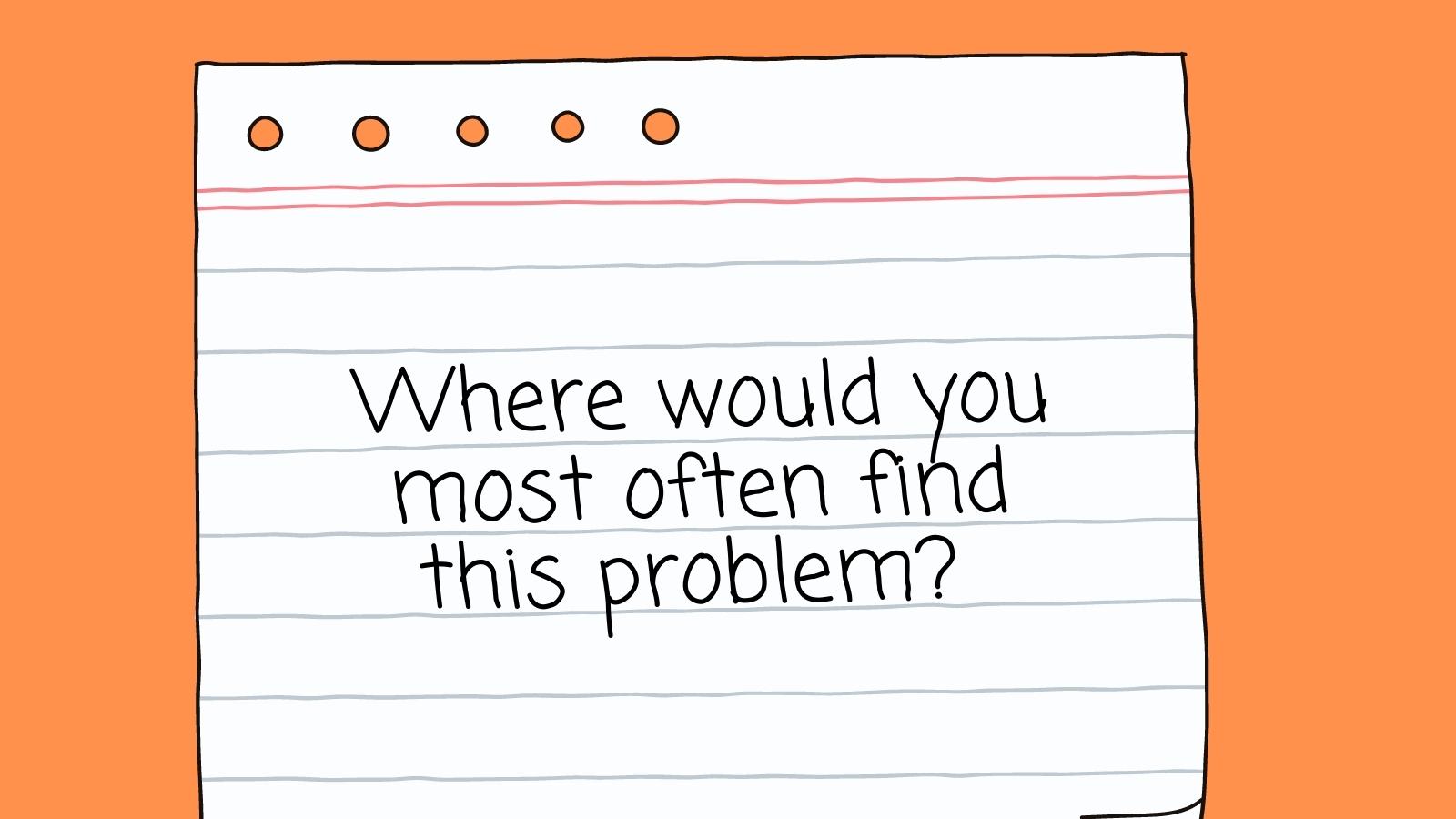
In an age of “fake news” claims and constant argument about pretty much any issue, critical thinking skills are key. Teach your students that it’s vital to ask questions about everything, but that it’s also important to ask the right sorts of questions. Students can use these critical thinking questions with fiction or nonfiction texts. They’re also useful when discussing important issues or trying to understand others’ motivations in general.
“Who” Critical Thinking Questions
Questions like these help students ponder who’s involved in a story and how the actions affect them. They’ll also consider who’s telling the tale and how reliable that narrator might be.
- Is the protagonist?
- Is the antagonist?
- Caused harm?
- Is harmed as a result?
- Was the most important character?
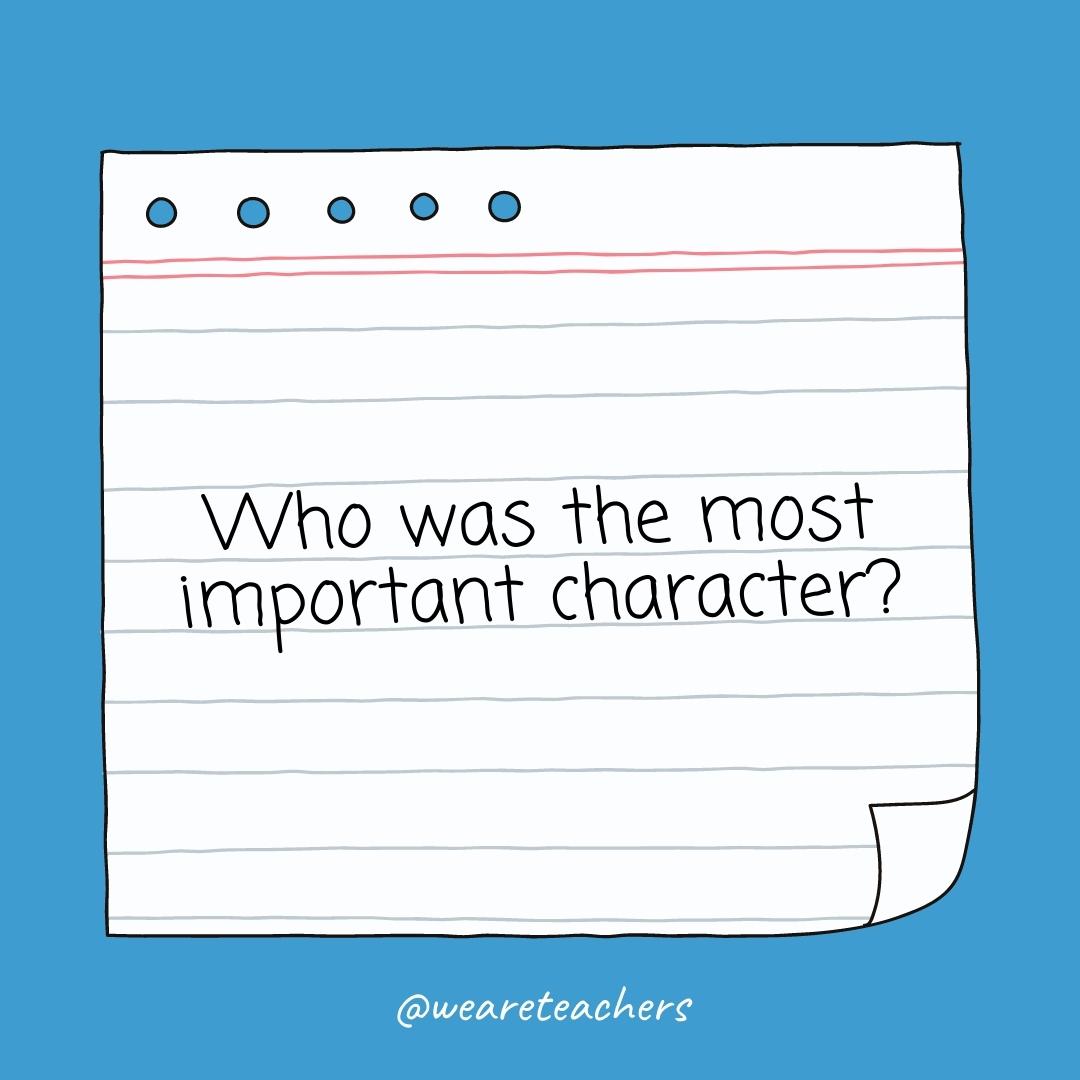
- Is responsible?
- Is most directly affected?
- Should have won?
- Will benefit?
- Would be affected by this?
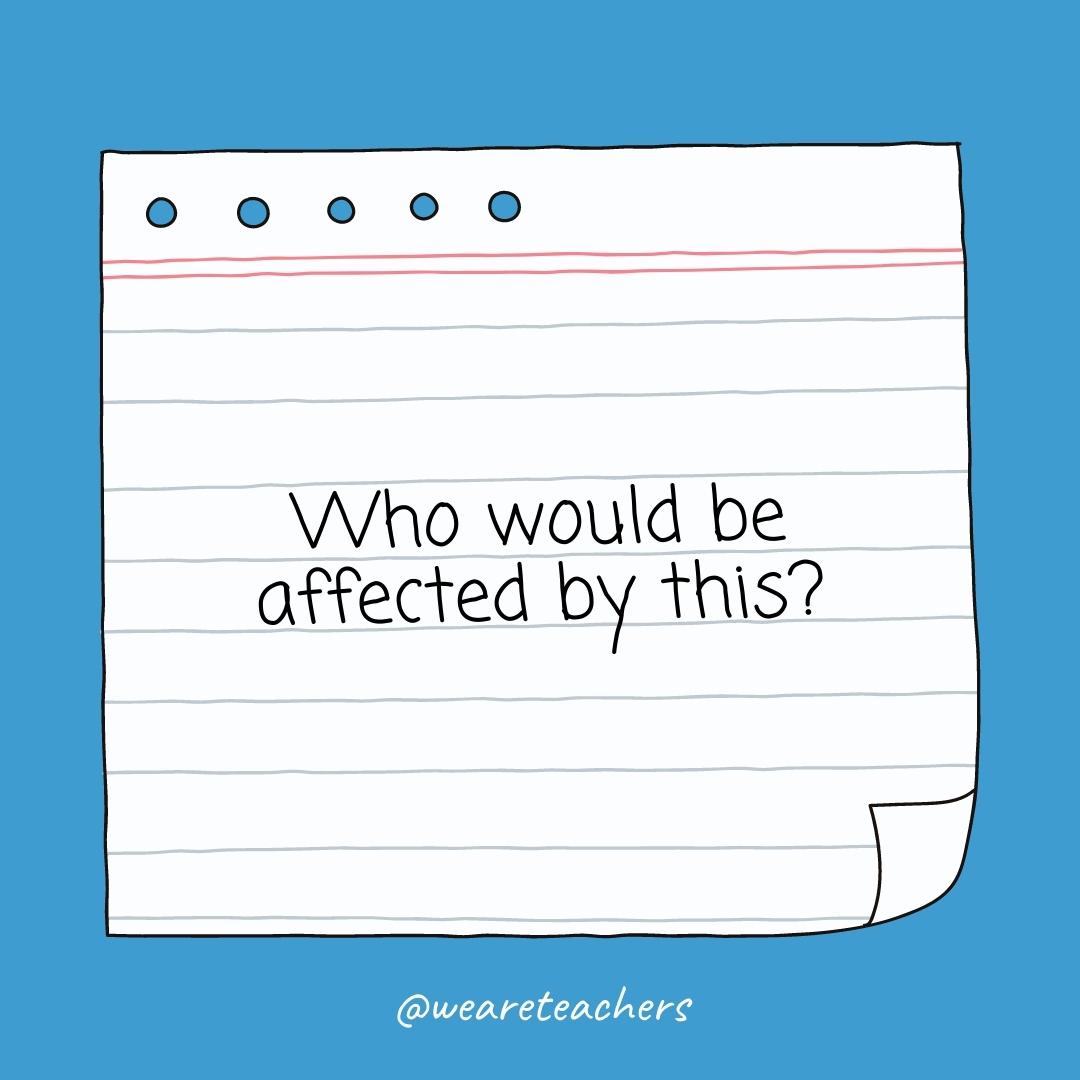
- Makes the decisions?
“What” Critical Thinking Questions
Ask questions that explore issues more deeply, including those that might not be directly answered in the text.
- Background information do I know or need to know?
- Is the main message?
- Are the defining characteristics?
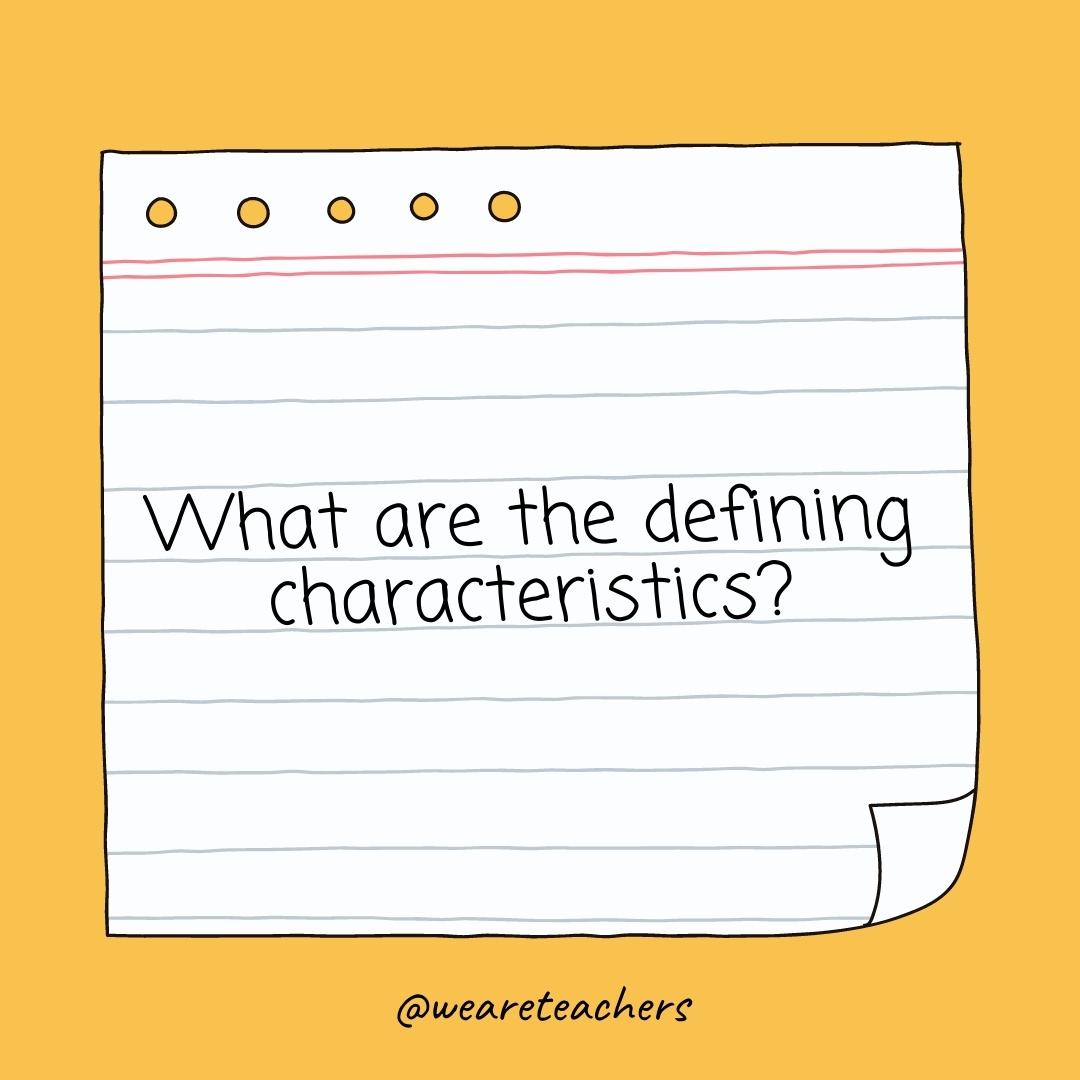
- Questions or concerns do I have?
- Don’t I understand?
- Evidence supports the author’s conclusion?
- Would it be like if … ?
- Could happen if … ?
- Other outcomes might have happened?
- Questions would you have asked?
- Would you ask the author about … ?
- Was the point of … ?
- Should have happened instead?
- Is that character’s motive?
- Else could have changed the whole story?
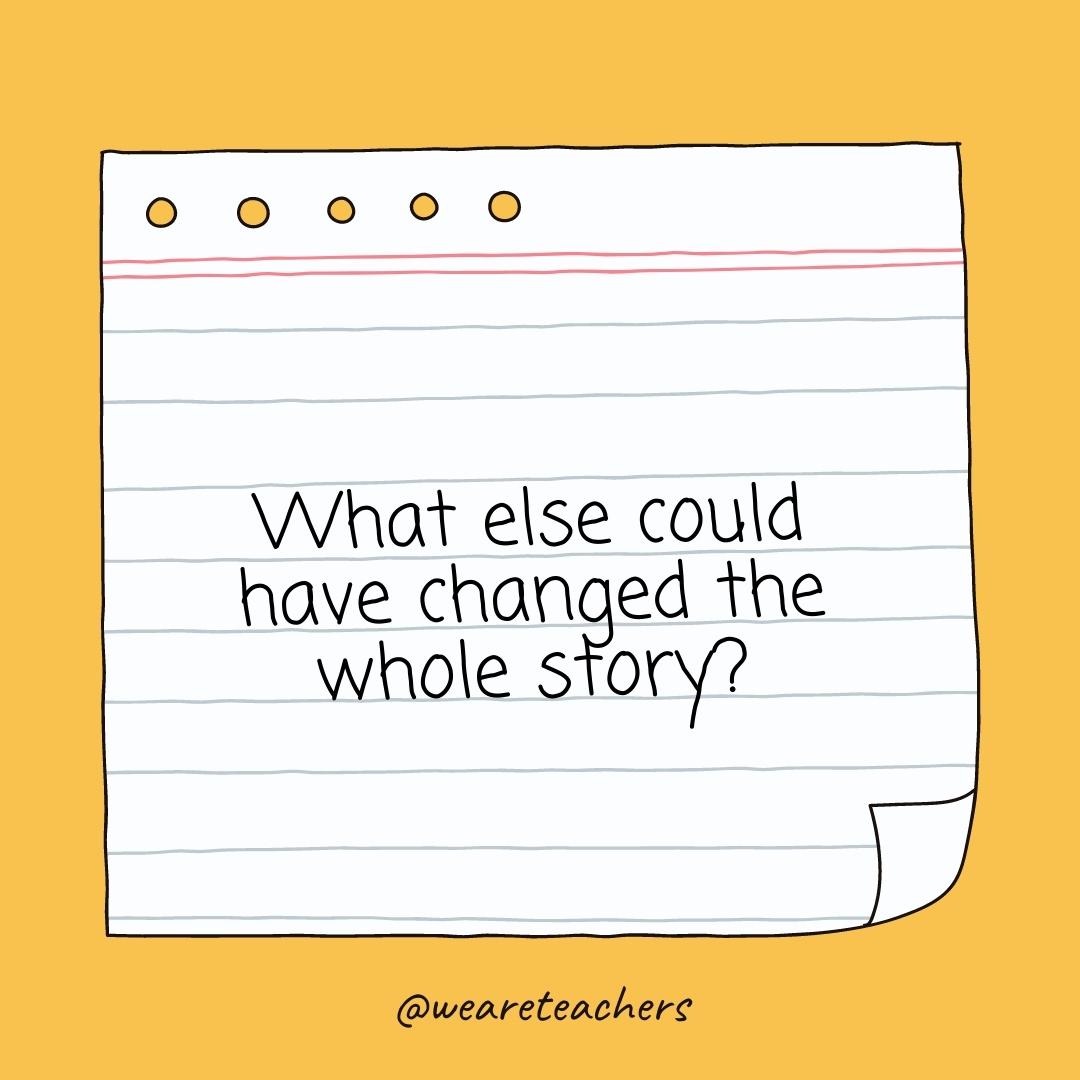
- Can you conclude?
- Would your position have been in that situation?
- Would happen if … ?
- Makes your position stronger?
- Was the turning point?
- Is the point of the question?
- Did it mean when … ?
- Is the other side of this argument?
- Was the purpose of … ?
- Does ______ mean?
- Is the problem you are trying to solve?
- Does the evidence say?
- Assumptions are you making?
- Is a better alternative?
- Are the strengths of the argument?
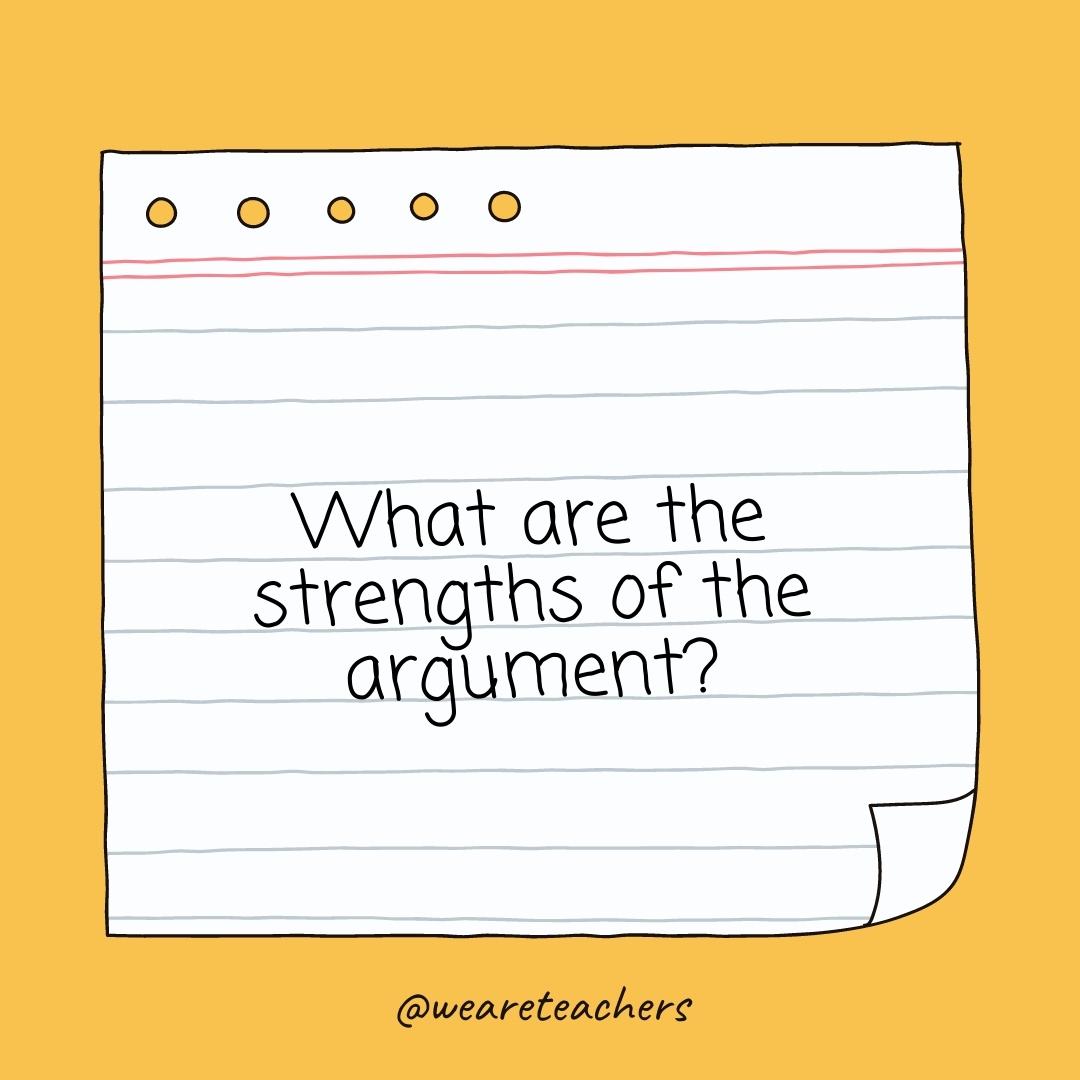
- Are the weaknesses of the argument?
- Is the difference between _______ and _______?
“Where” Critical Thinking Questions
Think about where the story is set and how it affects the actions. Plus, consider where and how you can learn more.
- Would this issue be a major problem?
- Are areas for improvement?
- Did the story change?
- Would you most often find this problem?

- Are there similar situations?
- Would you go to get answers to this problem?
- Can this be improved?
- Can you get more information?
- Will this idea take us?
“When” Critical Thinking Questions
Think about timing and the effect it has on the characters or people involved.
- Is this acceptable?
- Is this unacceptable?
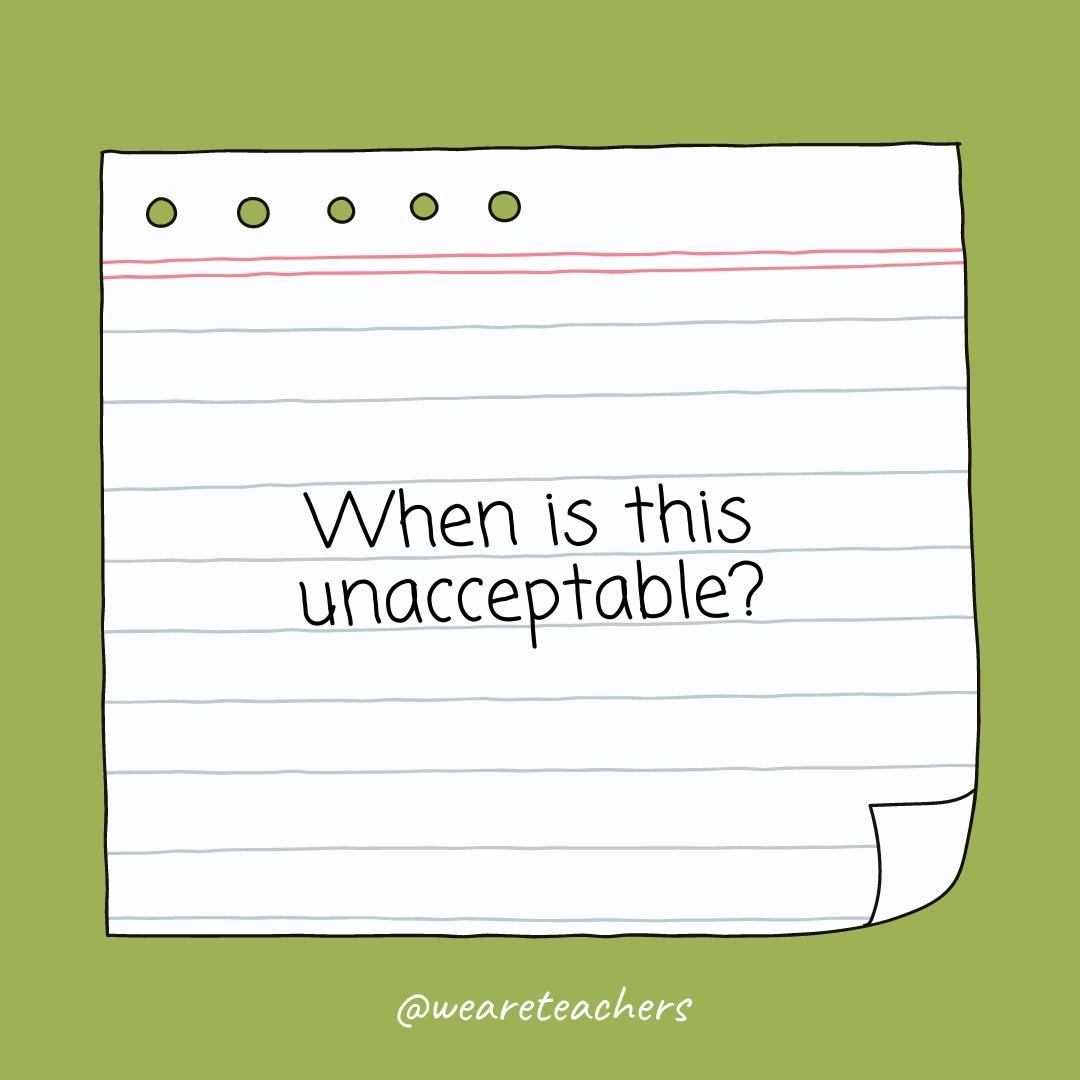
- Does this become a problem?
- Is the best time to take action?
- Will we be able to tell if it worked?
- Is it time to reassess?
- Should we ask for help?
- Is the best time to start?
- Is it time to stop?
- Would this benefit society?
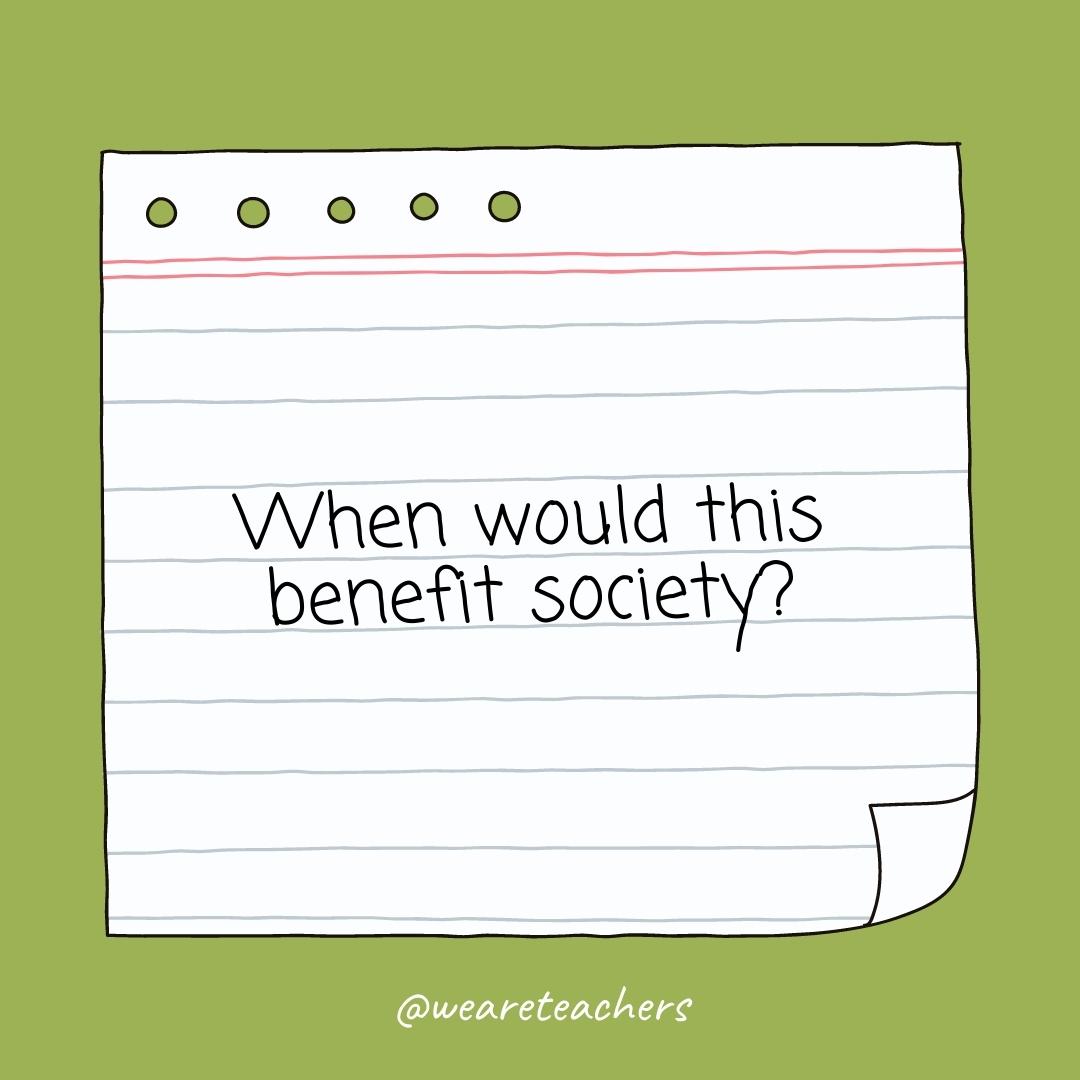
- Has this happened before?
“Why” Critical Thinking Questions
Asking “why” might be one of the most important parts of critical thinking. Exploring and understanding motivation helps develop empathy and make sense of difficult situations.
- Is _________ happening?
- Have we allowed this to happen?
- Should people care about this issue?
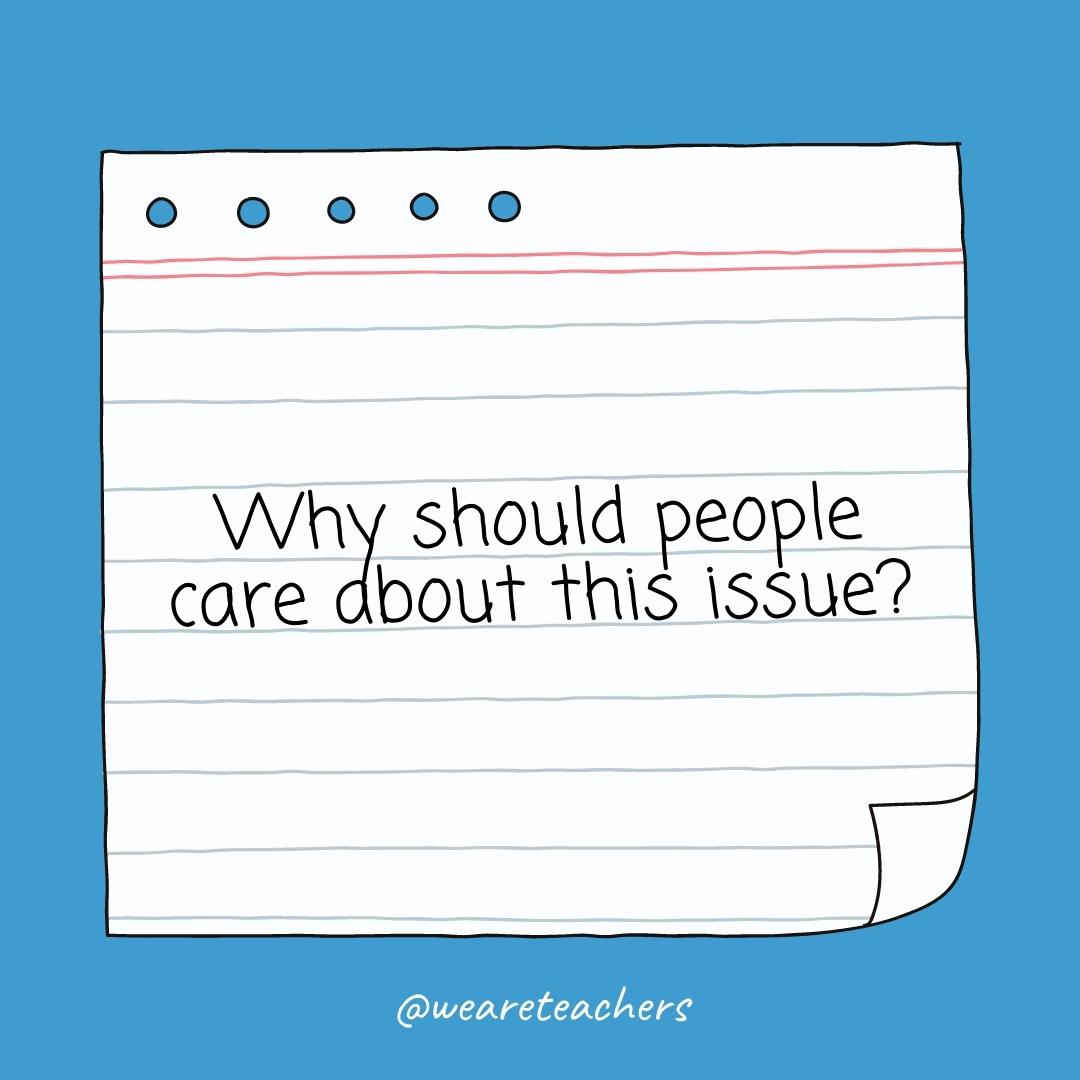
- Is this a problem?
- Did the character say … ?
- Did the character do … ?
- Is this relevant?
- Did the author write this?
- Did the author decide to … ?
- Is this important?
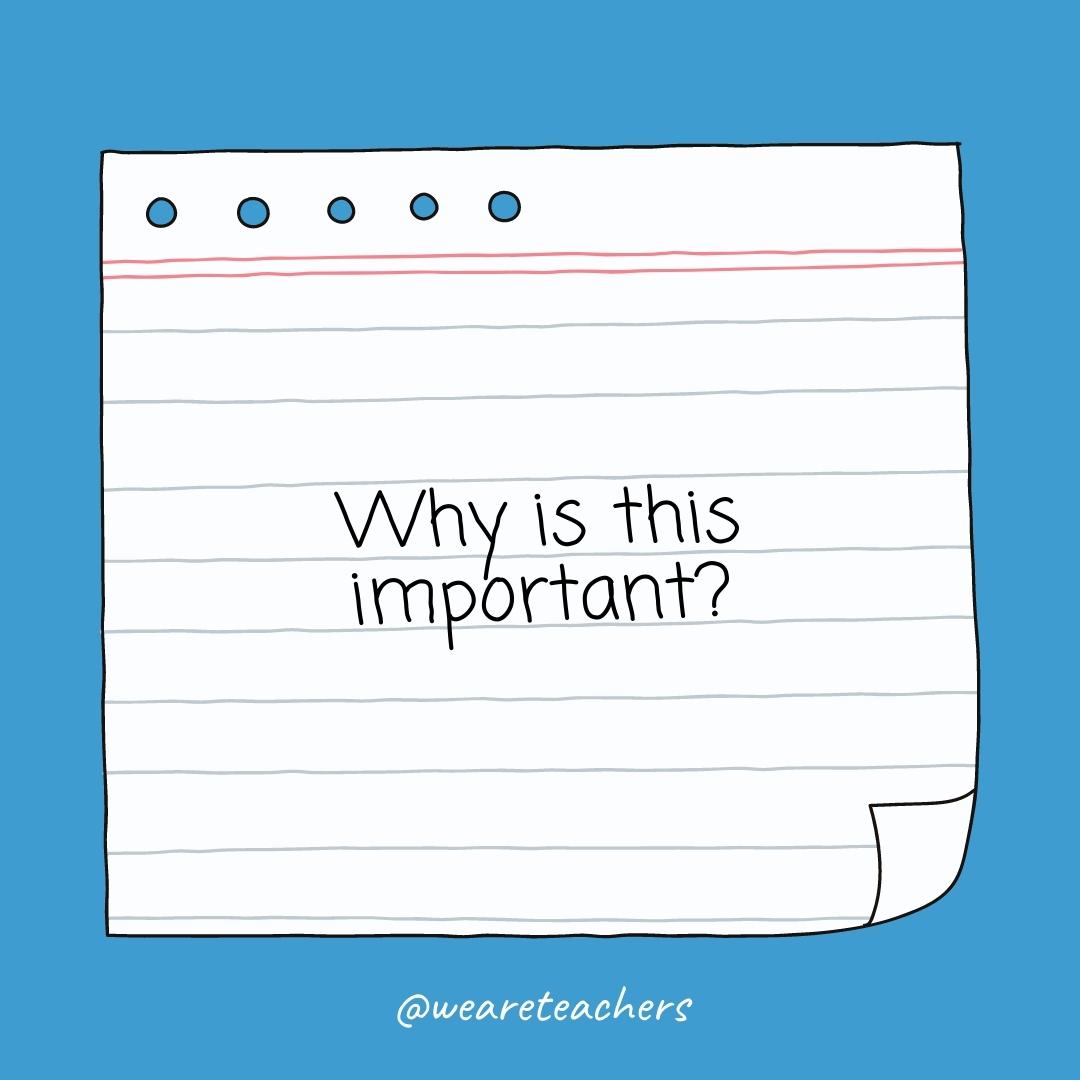
- Did that happen?
- Is it necessary?
- Do you think I (he, she, they) asked that question?
- Is that answer the best one?
- Do we need this today?
“How” Critical Thinking Questions
Use these questions to consider how things happen and whether change is possible.
- Do we know this is true?
- Does the language used affect the story?
- Would you solve … ?
- Is this different from other situations?
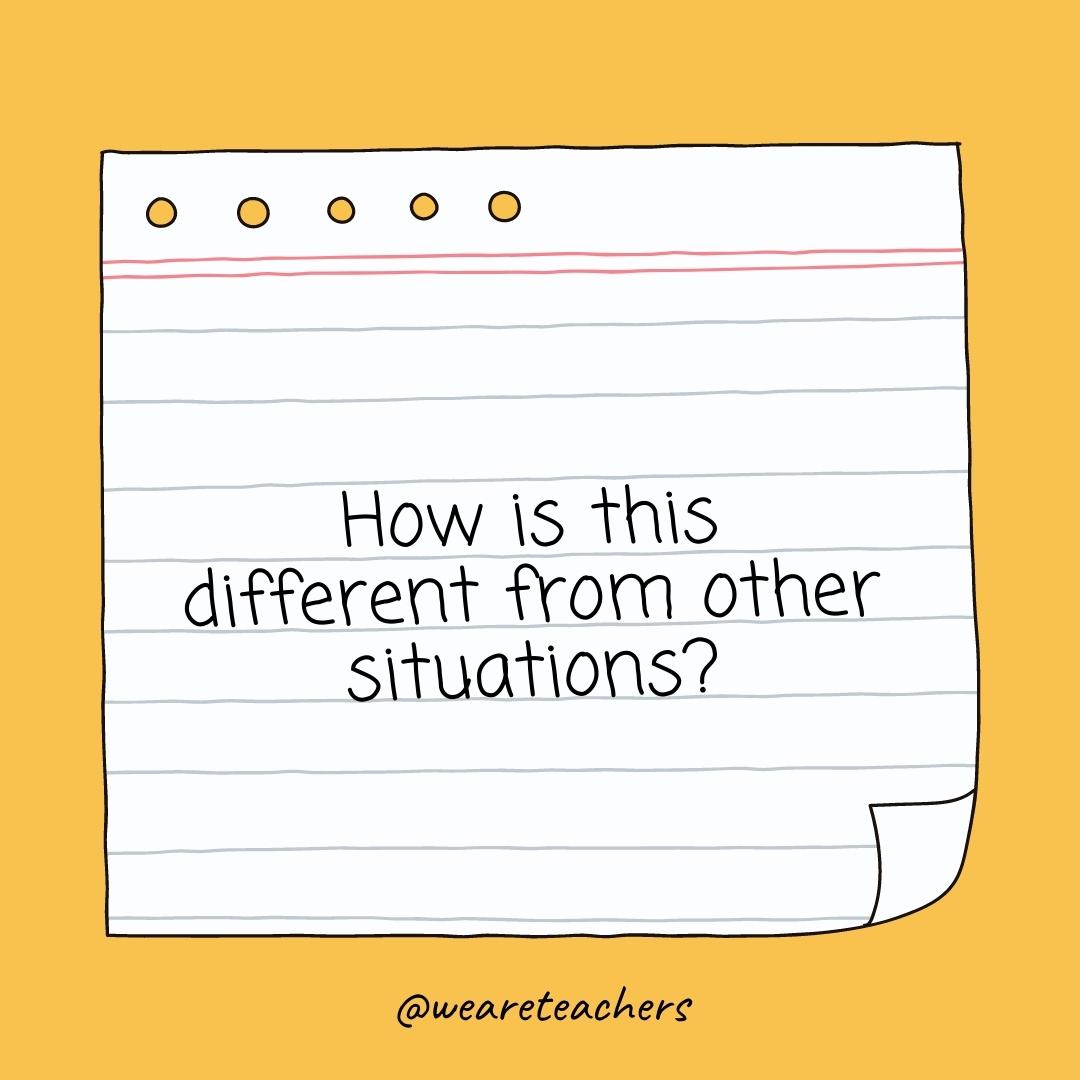
- Is this similar to … ?
- Would you use … ?
- Does the location affect the story?
- Could the story have ended differently?
- Does this work?
- Could this be harmful?
- Does this connect with what I already know?
- Else could this have been handled?
- Should they have responded?
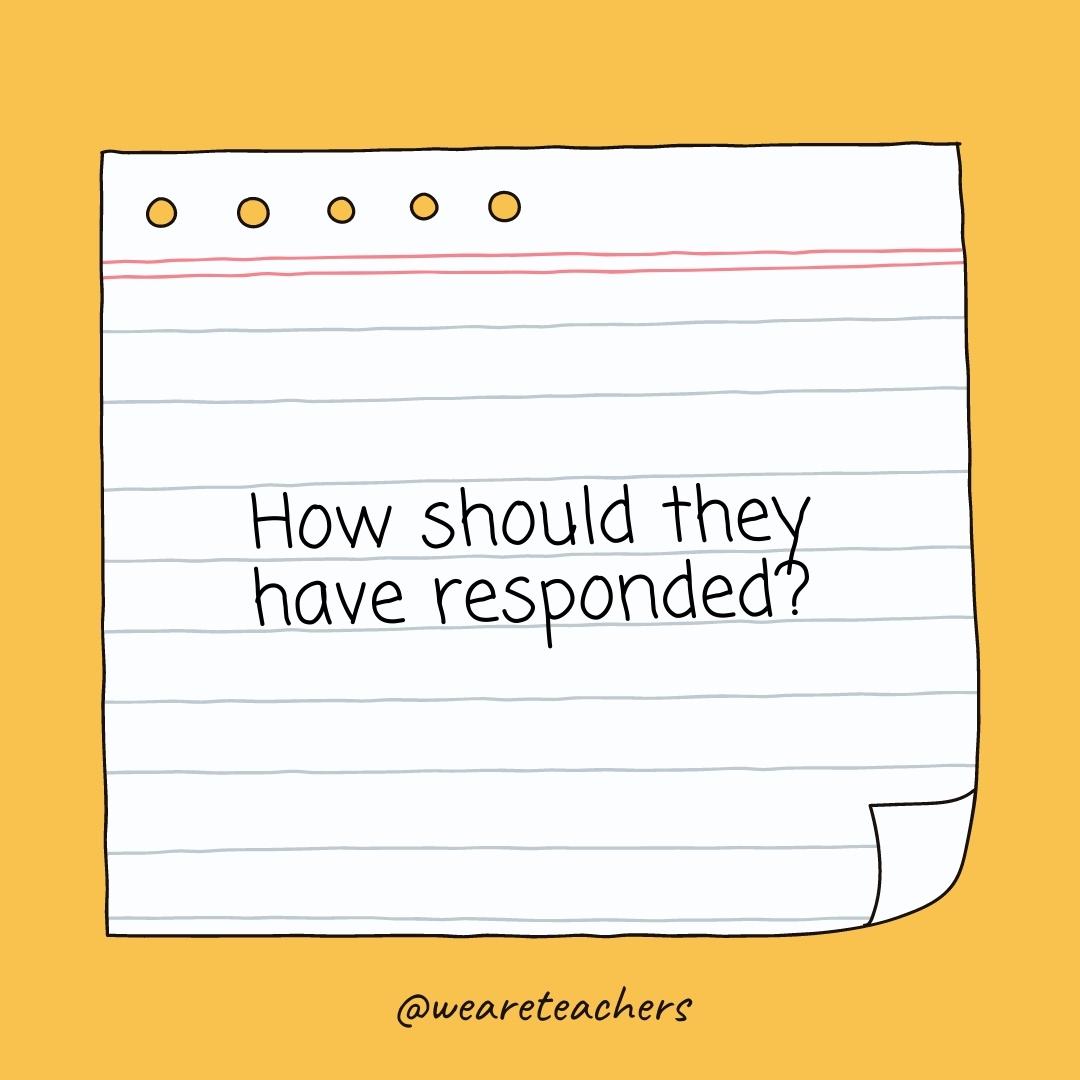
- Would you feel about … ?
- Does this change the outcome?
- Did you make that decision?
- Does this benefit you/others?
- Does this hurt you/others?
- Could this problem be avoided?
More Critical Thinking Questions
Here are more questions to help probe further and deepen understanding.
- Can you give me an example?
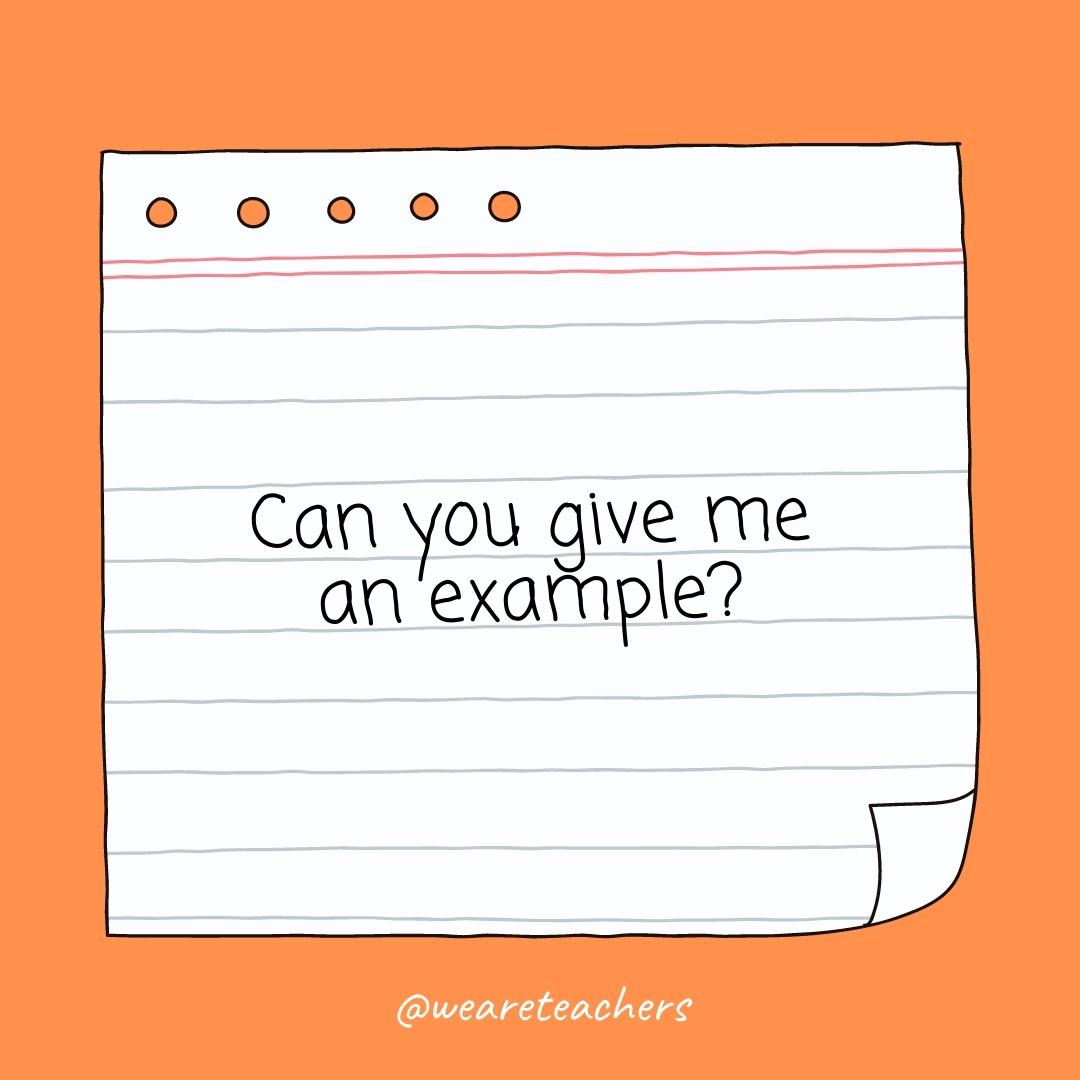
- Do you agree with … ?
- Can you compare this with … ?
- Can you defend the actions of … ?
- Could this be interpreted differently?
- Is the narrator reliable?
- Does it seem too good to be true?
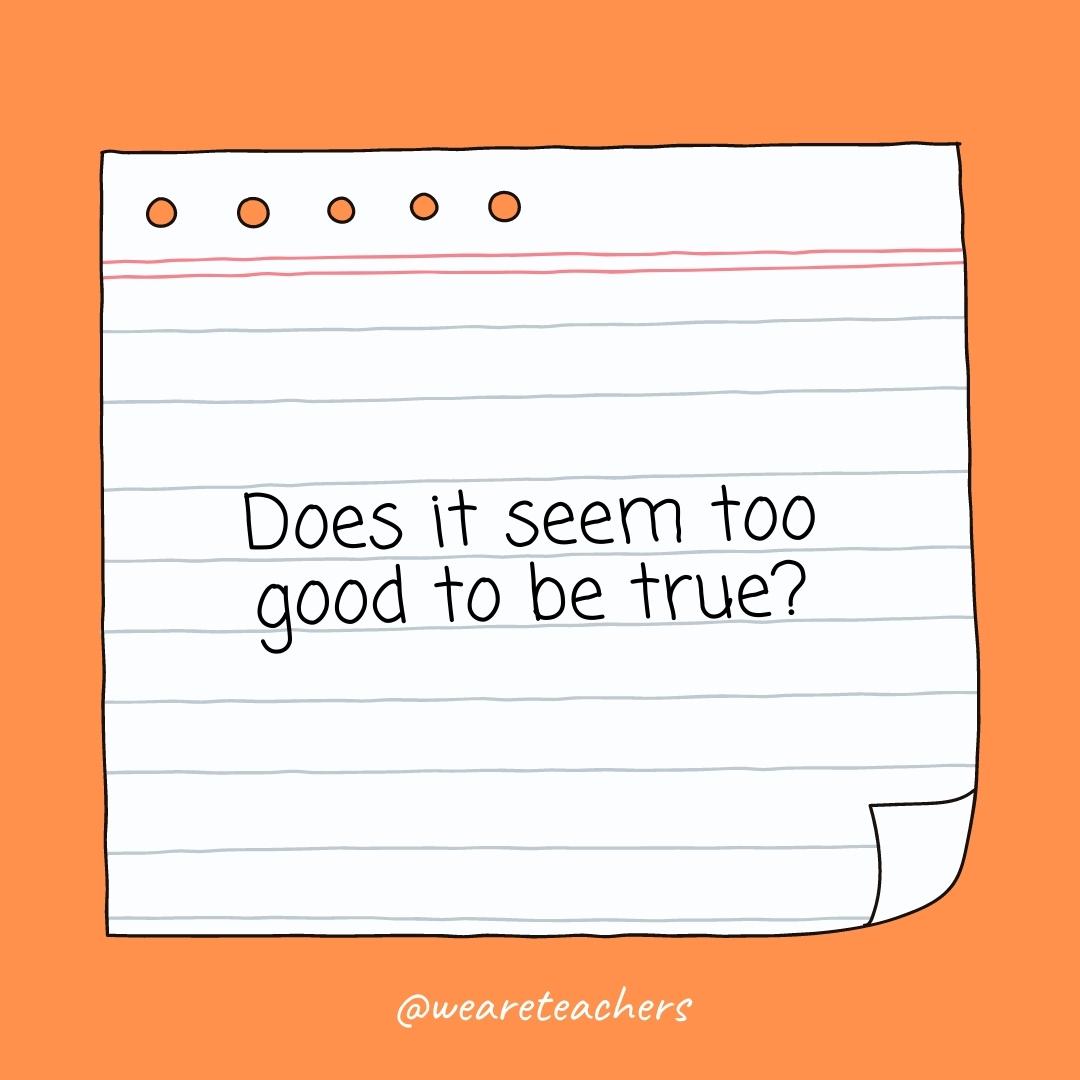
- Is ______ a fact or an opinion?
What are your favorite critical thinking questions? Come exchange ideas on the WeAreTeachers HELPLINE group on Facebook .
Plus, check out 10 tips for teaching kids to be awesome critical thinkers ., you might also like.
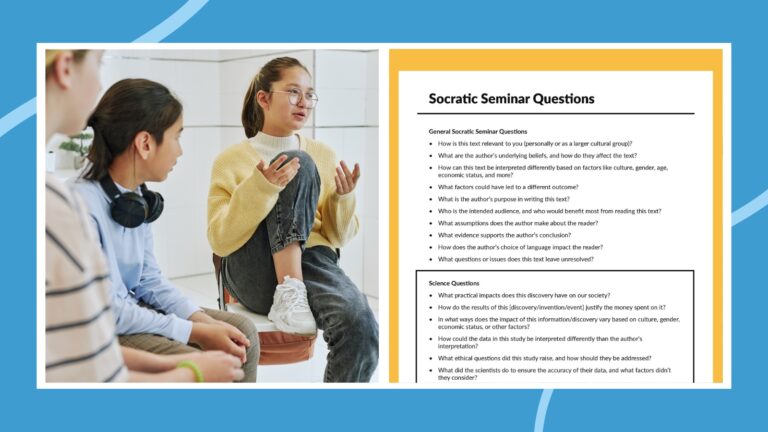
Socratic Seminar: Step-by-Step Guide and Questions (Free Printable)
Here's how to use this guided discussion strategy. Continue Reading
Copyright © 2024. All rights reserved. 5335 Gate Parkway, Jacksonville, FL 32256
Products and services
Our innovative products and services for learners, authors and customers are based on world-class research and are relevant, exciting and inspiring.
- Academic Research
- English Language Learning
- English Language Assessment
- Educational resources for schools
- Educational Research & Network
- Assessment Research
- Cambridge Assessment International Education
- Cambridge CEM
- Cambridge Partnership for Education
- Cambridge Dictionary
- The Cambridge Mathematics Project
We unlock the potential of millions of people worldwide. Our assessments, publications and research spread knowledge, spark enquiry and aid understanding around the world.
- People and planet
- News and insights
- Accessibility
- Rights and permissions
- Annual Report
No matter who you are, what you do, or where you come from, you’ll feel proud to work here.
- Language learning materials
- Language Assessment

A deep dive into critical thinking (part 1) – what is it and how is it taught?

Life Competencies Adult Learners Teens Young Learners Insights, Research and Linguistics
We all agree that critical thinking is important, but there is a lack of consensus about what critical thinking is and how to approach the teaching of it. In this post, we get critical about critical thinking and look at the biases that can affect your thoughts without you even realising!
Some believe that critical thinking skills can be generalised and applied to different contexts and subjects, and can be taught in a generic way. For example, understanding the links between ideas can be applied to any area of knowledge. Others believe that critical thinking skills can only be taught in the context of a specific subject. For example, the skills used with an opinion article (analysing the arguments, evaluating the evidence, identifying facts etc.) are different from those used with a scientific article, where the skills mentioned may not be as relevant as the application of the scientific method – establishing facts after making an observation, forming a hypothesis, making a prediction, conducting an experiment and analysing the results etc. There are also those who believe some skills are general while others are specific.
Breaking it down
So, before we can think of how education can help students to develop this skillset, we need to define what we believe critical thinking is and how to best teach it. The general principles are related to the ability of receiving, collecting and analysing information effectively. That is:
- identifying links between ideas,
- analysing and evaluating arguments,
- identifying patterns and relationships,
- separating what’s necessary from what’s irrelevant in a discussion,
- identifying gaps in reasoning,
- and using these skills to form an argument, solve a problem, or reach a conclusion.
Critical thinking in schools
In schools, critical thinking is mostly treated as a general skill that can be taught in a generic way. The academic load sure makes adding the teaching of critical thinking a challenge, let alone teaching the specific skills for each subject and area of knowledge. However, there is evidence that it’s very difficult for students to transfer the skills that they apply in one context to another. This supports the idea that there are different critical thinking skills for different areas of knowledge.
Daniel Willingham, professor of Psychology at the University of Virginia, published a paper in 2019 called ‘How to teach Critical Thinking’, which he wrote for the Department of Education in Australia. He believes that critical thinking is domain-specific – a specific skill related to a specific area of knowledge. He says that different areas of knowledge have different definitions of what it means to know something, and they apply analysis, synthesis, and evaluation in different ways.
So, does that mean that we can’t teach it as a general skill? Well, according to cognitive scientist Tim Van Gelder, that’s not necessarily true. He wrote an article called ‘Teaching Critical Thinking: Some Lessons From Cognitive Science’. Here, he talked about 6 lessons that summarised all the insights he had while studying critical thinking.
Without going into the specifics of the first 5 lessons, he explains that becoming an expert in critical thinking is hard and improving these skills takes time. Additionally, we need to have at least some theoretical knowledge about something to be able to think critically about it.
Van Gelder also said that students improve their critical thinking skills faster when they learn how to present their arguments in maps. Create a visually simple way to see the connections of ideas, reasons, assumptions and objections. This is effective because it helps learners to understand how arguments are constructed.
Critical thinking must be learned
Personally, I believe thinking critically is not natural. We can’t assume people know how to get information, understand it, question it, and use it effectively. It’s something that can be learned with life experiences and examples from the world around us. And we need to have discipline to incorporate it in our lives. I also believe that we need to have knowledge about something before we can think critically about it.
As for teaching this honed skill, it’s important to teach students about common sense, open-mindedness, skepticism, reasoning, logic, generalisation, correlation, causality – anything that can help them to develop critical thinking skills. Students must reflect on how their opinions are formed. They should know how they connect and combine assumptions, objections, and facts to form arguments. And finally, I firmly believe that we can’t really think critically unless we are aware of our biases. They can alter our perception of reality, our judgment, and our capacity to make impartial observations.
In part 2 of this blog, we will explore the different types of biases. What biases should you look out for? How can you avoid them? And what does this mean when applied to critical thinking? Be sure to check it out!
Check out the Cambridge Life Competencies booklet , which focuses on this one particular skill in detail. Read about this competency, download lesson plans and watch a short video on it, in Cambridge researcher Jasmin Silver’s critical thinking blog post .
You have to be logged in to save articles
The Captain of Class
Putting the "Class" in classroom.

Critical Thinking is Classy

What Does Critical Thinking Look Like?
I tried something new this year to get kids to introduce themselves to each other. The class visited the art room outside of their typical art time. Kids were told that they were going to make a self portrait . The catch was that they could only use scrap paper and glue; no drawing utensils, no scissors, only their hands and glue. They had a blast tearing the paper and sticking it together. Making shapes round was tricky. Some students made their art three-dimensional. Some used nonconventional colors.

After making the self portraits, students composed “Who Am I” riddle poems. They had to write down a list of sentences telling information about themselves that makes them unique from others in the class. They wrote their names on the back of the papers. I attached them to the self portraits. The kids got to read each other’s poems, guessing who fit the characteristics listed. The portraits were little more than clues, since they were not very realistic.

The project was not only presented several facets of critical thinking, but it also dressed up my room for Meet The Teacher Night! Parents loved trying to figure out which portrait/poem combination was their offspring:)
How to Foster Critical Thinking: Don’t Settle
When I have students figure out a math problem, I tell them to solve it multiple ways. This forces them to rethink the math. They are required to analyze the problem. My students are asked to not only “show their work”, but also explain how they arrived at their answers. When they share the process with a partner the two of them evaluate each other’s work. Having to find other ways to solve a math problem causes students to be creative, looking for novel ways to think about the numbers.

A way to inspire critical thinking during a writing assignment is through allowing students to view their peers’ written responses within Google Forms. When I administer an assessment through giving a quiz from Google classroom, I instruct my students to click on “See Previous Responses” upon submitting their quizzes. They are to read their classmates’ writing, evaluating the responses and comparing them with what they wrote. They may go back and add information to their own writing, then, adapting new ideas to the answer.

One More Thing: Call it what it is.

In order to critique something, one must create an opinion. With this end in mind, educators can work to teach students how to think critically in order to complete the task.
Watanabe-Crockett, L. (2015, July 24). The Importance of Teaching Critical Thinking. Retrieved September 22, 2018, from https://globaldigitalcitizen.org/the-importance-of-teaching-critical-thinking
Watanabe-Crockett, L. (2016, May 28). How to Develop A Critical Thinking Mindset in Elementary Students. Retrieved September 22, 2018, from https://globaldigitalcitizen.org/critical-thinking-mindset-elementary-students
Share this:
Published by.
Matt Weimann
Classy to the core, I teach the whole #3rdGrade child @EPSDWillowLane. I have eclectic tastes with interests in chess, cuisine, art, good literature, strong coffee and other drinks, jazz, and fashion... Mostly bowties;) View all posts by Matt Weimann
2 thoughts on “Critical Thinking is Classy”
- Pingback: “Sympathy for Creativity” A GarageBand Project – The Captain of Class
- Pingback: Paradoxically Powerful Parameters – The Captain of Class
Leave a comment Cancel reply

- Already have a WordPress.com account? Log in now.
- Subscribe Subscribed
- Copy shortlink
- Report this content
- View post in Reader
- Manage subscriptions
- Collapse this bar
Have a language expert improve your writing
Run a free plagiarism check in 10 minutes, generate accurate citations for free.
- Knowledge Base
- Working with sources
- What Is Critical Thinking? | Definition & Examples
What Is Critical Thinking? | Definition & Examples
Published on May 30, 2022 by Eoghan Ryan . Revised on May 31, 2023.
Critical thinking is the ability to effectively analyze information and form a judgment .
To think critically, you must be aware of your own biases and assumptions when encountering information, and apply consistent standards when evaluating sources .
Critical thinking skills help you to:
- Identify credible sources
- Evaluate and respond to arguments
- Assess alternative viewpoints
- Test hypotheses against relevant criteria
Table of contents
Why is critical thinking important, critical thinking examples, how to think critically, other interesting articles, frequently asked questions about critical thinking.
Critical thinking is important for making judgments about sources of information and forming your own arguments. It emphasizes a rational, objective, and self-aware approach that can help you to identify credible sources and strengthen your conclusions.
Critical thinking is important in all disciplines and throughout all stages of the research process . The types of evidence used in the sciences and in the humanities may differ, but critical thinking skills are relevant to both.
In academic writing , critical thinking can help you to determine whether a source:
- Is free from research bias
- Provides evidence to support its research findings
- Considers alternative viewpoints
Outside of academia, critical thinking goes hand in hand with information literacy to help you form opinions rationally and engage independently and critically with popular media.
Scribbr Citation Checker New
The AI-powered Citation Checker helps you avoid common mistakes such as:
- Missing commas and periods
- Incorrect usage of “et al.”
- Ampersands (&) in narrative citations
- Missing reference entries

Critical thinking can help you to identify reliable sources of information that you can cite in your research paper . It can also guide your own research methods and inform your own arguments.
Outside of academia, critical thinking can help you to be aware of both your own and others’ biases and assumptions.
Academic examples
However, when you compare the findings of the study with other current research, you determine that the results seem improbable. You analyze the paper again, consulting the sources it cites.
You notice that the research was funded by the pharmaceutical company that created the treatment. Because of this, you view its results skeptically and determine that more independent research is necessary to confirm or refute them. Example: Poor critical thinking in an academic context You’re researching a paper on the impact wireless technology has had on developing countries that previously did not have large-scale communications infrastructure. You read an article that seems to confirm your hypothesis: the impact is mainly positive. Rather than evaluating the research methodology, you accept the findings uncritically.
Nonacademic examples
However, you decide to compare this review article with consumer reviews on a different site. You find that these reviews are not as positive. Some customers have had problems installing the alarm, and some have noted that it activates for no apparent reason.
You revisit the original review article. You notice that the words “sponsored content” appear in small print under the article title. Based on this, you conclude that the review is advertising and is therefore not an unbiased source. Example: Poor critical thinking in a nonacademic context You support a candidate in an upcoming election. You visit an online news site affiliated with their political party and read an article that criticizes their opponent. The article claims that the opponent is inexperienced in politics. You accept this without evidence, because it fits your preconceptions about the opponent.
There is no single way to think critically. How you engage with information will depend on the type of source you’re using and the information you need.
However, you can engage with sources in a systematic and critical way by asking certain questions when you encounter information. Like the CRAAP test , these questions focus on the currency , relevance , authority , accuracy , and purpose of a source of information.
When encountering information, ask:
- Who is the author? Are they an expert in their field?
- What do they say? Is their argument clear? Can you summarize it?
- When did they say this? Is the source current?
- Where is the information published? Is it an academic article? Is it peer-reviewed ?
- Why did the author publish it? What is their motivation?
- How do they make their argument? Is it backed up by evidence? Does it rely on opinion, speculation, or appeals to emotion ? Do they address alternative arguments?
Critical thinking also involves being aware of your own biases, not only those of others. When you make an argument or draw your own conclusions, you can ask similar questions about your own writing:
- Am I only considering evidence that supports my preconceptions?
- Is my argument expressed clearly and backed up with credible sources?
- Would I be convinced by this argument coming from someone else?
If you want to know more about ChatGPT, AI tools , citation , and plagiarism , make sure to check out some of our other articles with explanations and examples.
- ChatGPT vs human editor
- ChatGPT citations
- Is ChatGPT trustworthy?
- Using ChatGPT for your studies
- What is ChatGPT?
- Chicago style
- Paraphrasing
Plagiarism
- Types of plagiarism
- Self-plagiarism
- Avoiding plagiarism
- Academic integrity
- Consequences of plagiarism
- Common knowledge
Don't submit your assignments before you do this
The academic proofreading tool has been trained on 1000s of academic texts. Making it the most accurate and reliable proofreading tool for students. Free citation check included.

Try for free
Critical thinking refers to the ability to evaluate information and to be aware of biases or assumptions, including your own.
Like information literacy , it involves evaluating arguments, identifying and solving problems in an objective and systematic way, and clearly communicating your ideas.
Critical thinking skills include the ability to:
You can assess information and arguments critically by asking certain questions about the source. You can use the CRAAP test , focusing on the currency , relevance , authority , accuracy , and purpose of a source of information.
Ask questions such as:
- Who is the author? Are they an expert?
- How do they make their argument? Is it backed up by evidence?
A credible source should pass the CRAAP test and follow these guidelines:
- The information should be up to date and current.
- The author and publication should be a trusted authority on the subject you are researching.
- The sources the author cited should be easy to find, clear, and unbiased.
- For a web source, the URL and layout should signify that it is trustworthy.
Information literacy refers to a broad range of skills, including the ability to find, evaluate, and use sources of information effectively.
Being information literate means that you:
- Know how to find credible sources
- Use relevant sources to inform your research
- Understand what constitutes plagiarism
- Know how to cite your sources correctly
Confirmation bias is the tendency to search, interpret, and recall information in a way that aligns with our pre-existing values, opinions, or beliefs. It refers to the ability to recollect information best when it amplifies what we already believe. Relatedly, we tend to forget information that contradicts our opinions.
Although selective recall is a component of confirmation bias, it should not be confused with recall bias.
On the other hand, recall bias refers to the differences in the ability between study participants to recall past events when self-reporting is used. This difference in accuracy or completeness of recollection is not related to beliefs or opinions. Rather, recall bias relates to other factors, such as the length of the recall period, age, and the characteristics of the disease under investigation.
Cite this Scribbr article
If you want to cite this source, you can copy and paste the citation or click the “Cite this Scribbr article” button to automatically add the citation to our free Citation Generator.
Ryan, E. (2023, May 31). What Is Critical Thinking? | Definition & Examples. Scribbr. Retrieved June 11, 2024, from https://www.scribbr.com/working-with-sources/critical-thinking/
Is this article helpful?

Eoghan Ryan
Other students also liked, student guide: information literacy | meaning & examples, what are credible sources & how to spot them | examples, applying the craap test & evaluating sources, get unlimited documents corrected.
✔ Free APA citation check included ✔ Unlimited document corrections ✔ Specialized in correcting academic texts
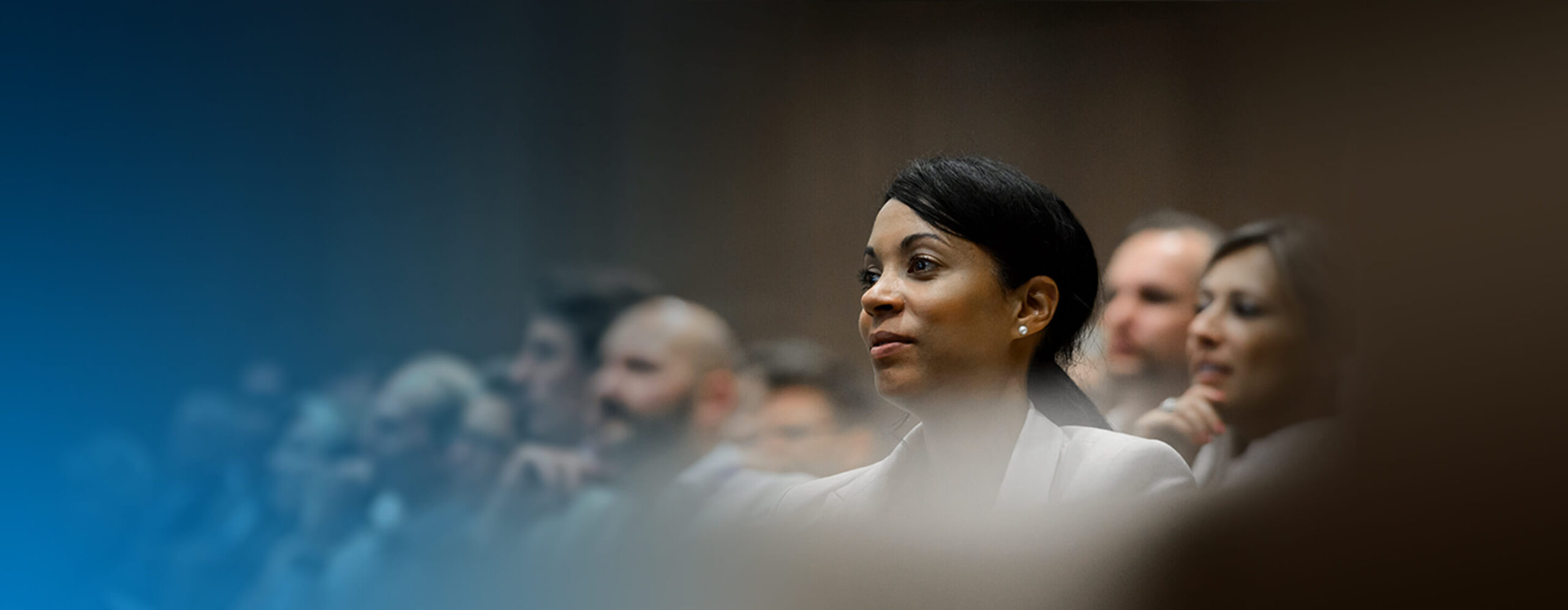
The 8 key leadership skills you need to know in 2024
Anyone can be placed in a leadership role, but to be good and thrive in that position requires solid leadership skills . Leadership skills are typically at the top of the list of competencies that recruiters focus on when hiring, or when managers are promoted from within an organization.
Effective leadership skills are crucial, both in a professional and personal capacity and are vital in facilitating effective team dynamics, driving success, managing change, and promoting personal and professional development.
Some of the world’s largest companies hunt for people with well-honed leadership skills to fill their most sought after executive positions.
8 key leadership skills you need to know about:
- Relationship building
- Agility and adaptability
- Innovation and creativity
- Employee motivation
- Decision-making
- Conflict management
- Negotiation
- Critical Thinking
1. Relationship building (the foundation of a high-performing team)
Some leaders will say they that they do not need to be loved in the workplace to succeed. This may be true, but to build a cohesive and more engaged team, great managers need the leadership skills to forge strong working relationships with their employees.
Leaders with strong, trusting and authentic relationships with their teams know that investing time in building these bonds makes them more effective as a leader, and creates a foundation for success.
Good working relationships increase employee engagement and according to Gallup’s meta-analysis of employee engagement, business units with good employee engagement have 41% fewer quality defects and 37% less absenteeism. A 21% increase in productivity was also seen to result from higher employee engagement.
So even if you think you don’t need to be loved in the workplace, you will definitely need to be skilled in building good relationships in order to be an effective leader.
If your team is highly engaged and happy in the workplace, you are likely to be well respected as a leader with employees who love what they do, and hopefully the strong relationships you cultivate will help your team perform at their highest level.
Tips for leaders to navigate relationships in the workplace »
2. Agility and adaptability (stay at the cutting edge as a leader)
In a study conducted by Development Dimensions International in 2008, one of the most important leadership qualities, was the ability to facilitate change. Fast-forward to 2024, adaptability is one of the most important leadership skills.
Leaders need to contend with a hyper-competitive business environment, geo-politics, climate change, the changes advanced by the COVID-19 pandemic and many more factors, all of which require leaders to adapt and develop agility.
Effective leaders must be able to adapt to both internal, and external changes – even if that means working outside of your comfort zone. As a leader you need to develop a lifelong learning mentality to ensure that you are not left behind by shifts in your industry, and can give your business the competitive edge. This is where as a leader you need to be agile and adaptable, which is easier said than done.
One key way to develop leadership agility and adaptability is to be accountable and assume your responsibilities, making sure that you have laid out a plan on how you should respond to change.
This plan should contain an achievable timeline, allowing you to constantly check your progress on how well you are adapting to the change and how you are exemplifying this to your team.
Read IMD article on agile leadership in an age of digital disruption »
3. Innovation and creativity (learn to push your boundaries)
Innovation in leadership is of utmost importance for every company. Successful innovation begins with ideation — the phase where outstanding ideas are developed and become the foundation of innovation success.
Consider some of the industry leaders, what did it take for Apple to become a leader technology industry? They made innovations to products with their customers in mind.
Steve Jobs, and perhaps even more so Tim Cook led the innovation and creativity for Apple Inc. by continuously forging ahead of the competition, and this probably made them some of the most innovative leaders within the tech industry.
The increasing demand for creativity and innovation will continue to be a driving force for executives, as who must harness their leadership skills in these areas to be effective and competitive.
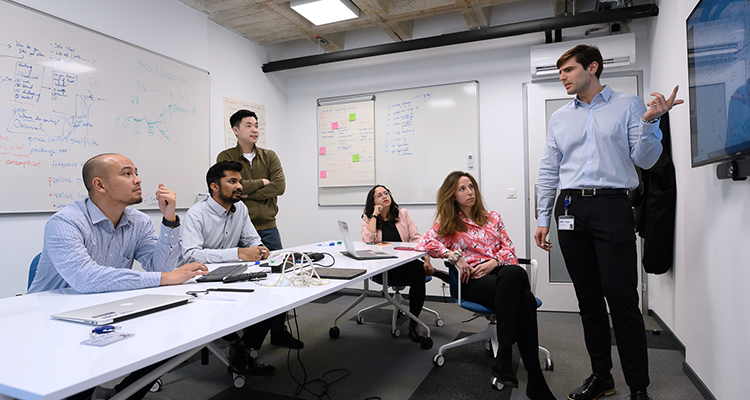
4. Employee motivation (improve engagement and efficiency)
In close connection with relationship building, the ability to motivate your workforce is as important as keeping employee engagement high. One of the most effective leadership skills is knowing how to continuously motivate employees, which requires leaders to be connected to their teams and attentive to what is going on around them.
In a study done by the firm Interact on 10,000 employees in the US which cited that the number 1 complaint (63%) from employees concerning their managers is lack of appreciation, and, conversely, when managers appreciate their contribution, their engagement increases by 60%.
In another study by Westminster College, it was found that boosting morale is the top (32%) motivational technique employees prefer. If employees are not motivated, the company can be negatively affected (financially) with absenteeism, attrition and low productivity.
Motivated employees are much more engaged, they are also more self-confident in what they do, and can do. This leads them to know how to react in difficult situations and develop innovative ideas that could help optimize business performance.
5. Decision-making (leading with conviction)
A leader is tasked with making decisions all the time. To be an effective leader, those decision making skills need to be top notch. Critical decisions affecting your organization on a large scale need to be sound, rational and solid.
In reality, your decisions as a leader will determine your – and potentially your organization’s – success. Making decisions, however big or small, are a fundamental part of Leadership, as a leader you need to develop strong decision-making skills and have the conviction to stand by your decisions, whilst also recognizing the need to adapt when those decisions do not lead to the desired outcome. It is a unique balancing act.
Remember, some decisions may not always be favorable. Making an unpopular but necessary decision is probably one of the most difficult tasks as a leader, but it is vital that as a leader you are able to recognize your responsibilities and make clear decisions for your team or organization.
📝 Try an exercise for better decision making »
6. Conflict management (keeping the peace)
According to the American Management Association, managers spend at least 24% of their time managing conflict. Conflict can happen in any area of business.
A conflict is considered to be any issue between two or more individuals that can potentially disrupt work. Conflict in business may go beyond the workplace as it can involve customers, suppliers and even competitors.
When a conflict arises, an effective leader should be able to jump in and resolve or at least mitigate the conflict before it affects the business negatively. When properly dealt with, a conflict may even turn out to be positive for your organization, as it can often lead to stronger bonds or new ideas.
To be effective as a leader, you must be good at identifying conflict, and have foresight on how to resolve it. It is also essential to be rational when faced with confrontation. Conflict management is no doubt one of the most important leadership competencies but Robyn Short cited a study that found 60% of U.S. employees have not received any conflict management skills training.
As a leader, it is important that you are able to manage conflict, but developing these same skills in your team can help avoid conflict altogether.
How to manage conflict: Six essentials from a former FBI hostage negotiator »
7. Negotiation (winning the game)
Negotiation is a process where two parties with different ideals get together and mutually agree on what an outcome should be. According to Skills You Need, the process of negotiation involves 6 stages:
- Preparation
- Clarification of goals
- Negotiation towards a Win-Win outcome
- Implementation of a course of action
Good negotiations can be beneficial to an organization because they will build better relationships, both internally and externally. They will also help find the best long-term solution by getting the most out of two different sides. An effective leader must be well versed in his negotiation style to move an organization forward.
As a leader, negotiation is used to understand the interests of your employees and to find ways of satisfying those interests, in order to achieve organizational goals.
Tips on using negotiation to achieve positive outcomes »
Subscribe for more great leadership content 💌
Subscribe now for exclusive content from imd.
8. Critical Thinking (understand the links between ideas)
Leading a business is unquestionably challenging. To be successful, a leader must make a lot of difficult decisions, often under pressure. Research by the Brandon Hall Group shows that critical thinking is the most important skill required of leaders to successfully lead an organization.
Critical thinking is the ability to think clearly, whilst building a logical connection between different ideas. Critical thinkers are often intelligent decision makers, highly analytical and generally always rational. Critical thinking is a learned skill, and generally involves three steps:
Step 1 – Frame
Complex problems are rarely what they appear to be on first look. To better understand what you are dealing with, frame the problem by asking yourself “What is my problem?” Hint: you can safely assume that whatever you think your problem is right now probably isn’t your actual problem.
Step 2 – Explore
Do not rely on intuition. No matter how much faith you have in your own judgment, if you rely strictly on your instincts you will miss the opportunity to see things from an alternative perspective. Instead, explore potential solutions. That is, ask yourself “How may I solve my problem?” It is equally important to explore what matters to you; that is, the various attributes of a solution that would make it more attractive to you.
Step 3 – Decide
In most cases, one solution isn’t consistently superior to all others on all attributes. To make your decision, answer your question, “How should I solve my problem?” Surface the trade-offs for each solution, identifying what you are ready to give away that you value so that you can get a little more of something else that you value even more.
Frame, explore, decide, or FrED, for short. For most complex problems, your understanding of the problem changes as you progress through the analysis. The three steps aren’t so much a linear sequence as they are elements of an iterative loop. Do not hesitate to revise previous conclusions as new evidence surfaces.
Typically, critical thinkers will rigorously question ideas and assumptions, they will always seek to determine whether the ideas, arguments and findings represent the true picture and are commonly able to recognize inconsistencies and errors in reasoning to achieve the desired outcome.
Sharpen your critical thinking skills with IMD »

Leadership is crucial to the success of individuals, teams, and organizations. It encompasses diverse skills, qualities, and approaches that empower individuals to guide and inspire others toward achieving common goals. As the business environment continues to evolve, so will the concept of leadership — adapting to meet the demands and challenges of a dynamic world. […]
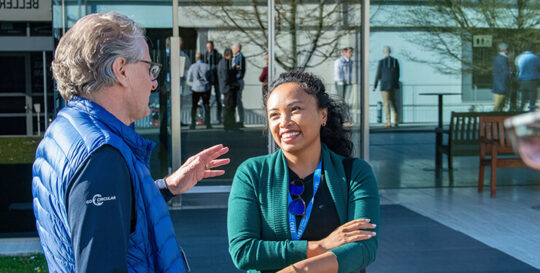
Imagine navigating a ship through uncharted waters in the dark, with each crew member holding a piece of the map. That’s the challenge of leadership in today’s dynamic, ever-evolving business landscape. How do you, as a leader, unite these diverse pieces to chart a successful course? The answer lies in inclusive leadership. In a world […]
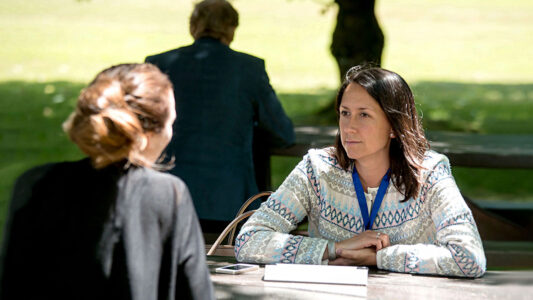
What if you could supercharge your leadership development in a way that’s tailored specifically to you? Today’s business leaders are under immense pressure to deliver. It’s not just about achieving quarterly targets; it’s about being a visionary, a strategic thinker, and a great manager. That’s where executive coaching comes in. Far from being a sign […]
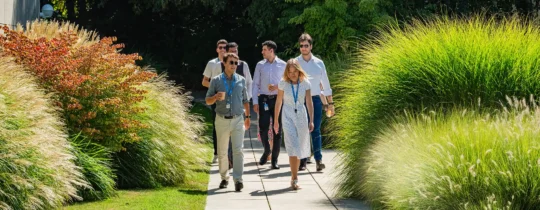
Do you believe each team member has a unique strength that can fuel innovation and solve complex challenges? If your answer is yes, you might want to explore the landscape of laissez-faire leadership. Laissez-faire leadership, a term many have heard but few completely understand, is growing more relevant in today’s ever-changing, complex work environments. It […]

IMAGES
VIDEO
COMMENTS
The premise here is straightforward: clarifying what critical thinking might 'look like' in the classroom. Put another way, what are some indicators that rational thought and careful, critical thinking is not just 'visible,' but a part of the culture of a classroom. In Critical Thinking Is A Mindset, I offered that, ...
What does critical thinking look like in the classroom? Critical thinking in the classroom looks like examining and brainstorming. It's a fearlessness to analyze, test, and even reject ideas. It's metacognition, which is simply thinking about thinking. Critical thinking happens when teachers ask thought-provoking questions and resist the ...
Students grappled with ideas and their beliefs and employed deep critical-thinking skills to develop arguments for their claims. Embedding critical-thinking skills in curriculum that students care ...
Critical thinking is a key skill that goes far beyond the four walls of a classroom. It equips students to better understand and interact with the world around them. Here are some reasons why fostering critical thinking is important: Making Informed Decisions: Critical thinking enables students to evaluate the pros and cons of a situation ...
Teach Reasoning Skills. Reasoning skills are another key component of critical thinking, involving the abilities to think logically, evaluate evidence, identify assumptions, and analyze arguments. Students who learn how to use reasoning skills will be better equipped to make informed decisions, form and defend opinions, and solve problems.
The Foundation for Critical Thinking says, "Critical thinking can be seen as having two components: 1) a set of information and belief-generating and processing skills, and 2) the habit, based on intellectual commitment, of using those skills to guide behavior.". In other words, good critical thinkers know how to analyze and evaluate ...
Critical thinking blasts through the surface level of a topic. It reaches beyond the who and the what and launches students on a learning journey that ultimately unlocks a deeper level of ...
What does critical thinking in the classroom actually look like? In the interest of bridging the gap between aspiration and achievement in the area of critical thinking, Browne & Freeman (2000 ...
Modeling of critical thinking skills by instructors is crucial for teaching critical thinking successfully. By making your own thought processes explicit in class - explaining your reasoning, evaluating evidence for a claim, probing the credibility of a source, or even describing what has puzzled or confused you - you provide a powerful example to students
Critical thinking in the classroom is a common term used by educators. Critical thinking has been called "the art of thinking about thinking" (Ruggiero, V.R., 2012) with the intent to improve one's thinking. ... do. They practice their skills much like any learned skill. Critical thinkers typically (Ruggiero, 2012):
Provide students with a Critical Thinking rubric. (Have them look at the rubric before a critical thinking activity, and once again when they are finished) Make assessment of Critical Thinking an ongoing effort. (While the teacher can assess, have students assess themselves. Self assessment can be powerful) Concentrate on specific indicators in ...
Critical thinking is, in short, self-directed, self-disciplined, self-monitored, and self-corrective thinking. It presupposes assent to rigorous standards of excellence and mindful command of their use. It entails effective communication and problem solving abilities and a commitment to overcome our native egocentrism and sociocentrism.
It makes you a well-rounded individual, one who has looked at all of their options and possible solutions before making a choice. According to the University of the People in California, having critical thinking skills is important because they are [ 1 ]: Universal. Crucial for the economy. Essential for improving language and presentation skills.
In order to become a well-rounded person who has developed critical thinking skills, students must first understand the importance of developing these skills. This means teaching students how to analyze data, evaluate arguments, and draw conclusions from evidence. This article will help teachers teach critical thinking skills in the class room.
A complete guide to teaching Critical Thinking. This 180 page e-book is an excellent resource for teachers looking to implement critical thinking in the classroom. It is packed full of great content whether you are just starting out, or looking to go further. It makes relevant connections to technology, STEM, and critical and creative thinking.
The Question Formulation Technique (QFT) process facilitates curiosity and critical thinking . It allows students to drive the inquiry by asking their own questions that are sparked by a question ...
By using a few strategies, teachers can encourage positive learning outcomes.
Encourage careful reading and deeper connections with this list of critical thinking questions. ... Administrator Professional Development Assessment Back to School Creative Classroom Education Resources End of School Year English Language Arts Featured Financial Literacy ... "Who" Critical Thinking Questions. Questions like these help ...
See why leading organizations rely on MasterClass for learning & development. Fostering higher-order thinking skills (HOTS) is an important aspect of teaching students at all stages of their lives. These skills make students effective problem-solvers and form the building blocks of critical and creative thinking on a wider scale.
Level Up Your Team. See why leading organizations rely on MasterClass for learning & development. Many decision-making and problem-solving tasks require critical thinking skills, which entail the ability to analyze information to reach a rational conclusion.
Inspire creativity. Imagination is key to teaching critical thinking in elementary school. Teachers should seek out new ways for students to use information to create something new. Art projects are an excellent way to do this. Students can also construct inventions, write a story or poem, create a game, sing a song—the sky's the limit.
In schools, critical thinking is mostly treated as a general skill that can be taught in a generic way. The academic load sure makes adding the teaching of critical thinking a challenge, let alone teaching the specific skills for each subject and area of knowledge. However, there is evidence that it's very difficult for students to transfer ...
What Does Critical Thinking Look Like? I tried something new this year to get kids to introduce themselves to each other. The class visited the art room outside of their typical art time. Kids were told that they were going to make a self portrait. The catch was that they could only use scrap paper and glue; no drawing utensils, no scissors ...
Critical thinking is the ability to effectively analyze information and form a judgment. To think critically, you must be aware of your own biases and assumptions when encountering information, and apply consistent standards when evaluating sources. Critical thinking skills help you to: Identify credible sources. Evaluate and respond to arguments.
Innovation and creativity. Employee motivation. Decision-making. Conflict management. Negotiation. Critical Thinking. 1. Relationship building (the foundation of a high-performing team) Some leaders will say they that they do not need to be loved in the workplace to succeed.
Critical thinking is, in short, self-directed, self-disciplined, self-monitored, and self-corrective thinking. It presupposes assent to rigorous standards of excellence and mindful command of their use. It entails effective communication and problem solving abilities and a commitment to overcome our native egocentrism and sociocentrism.